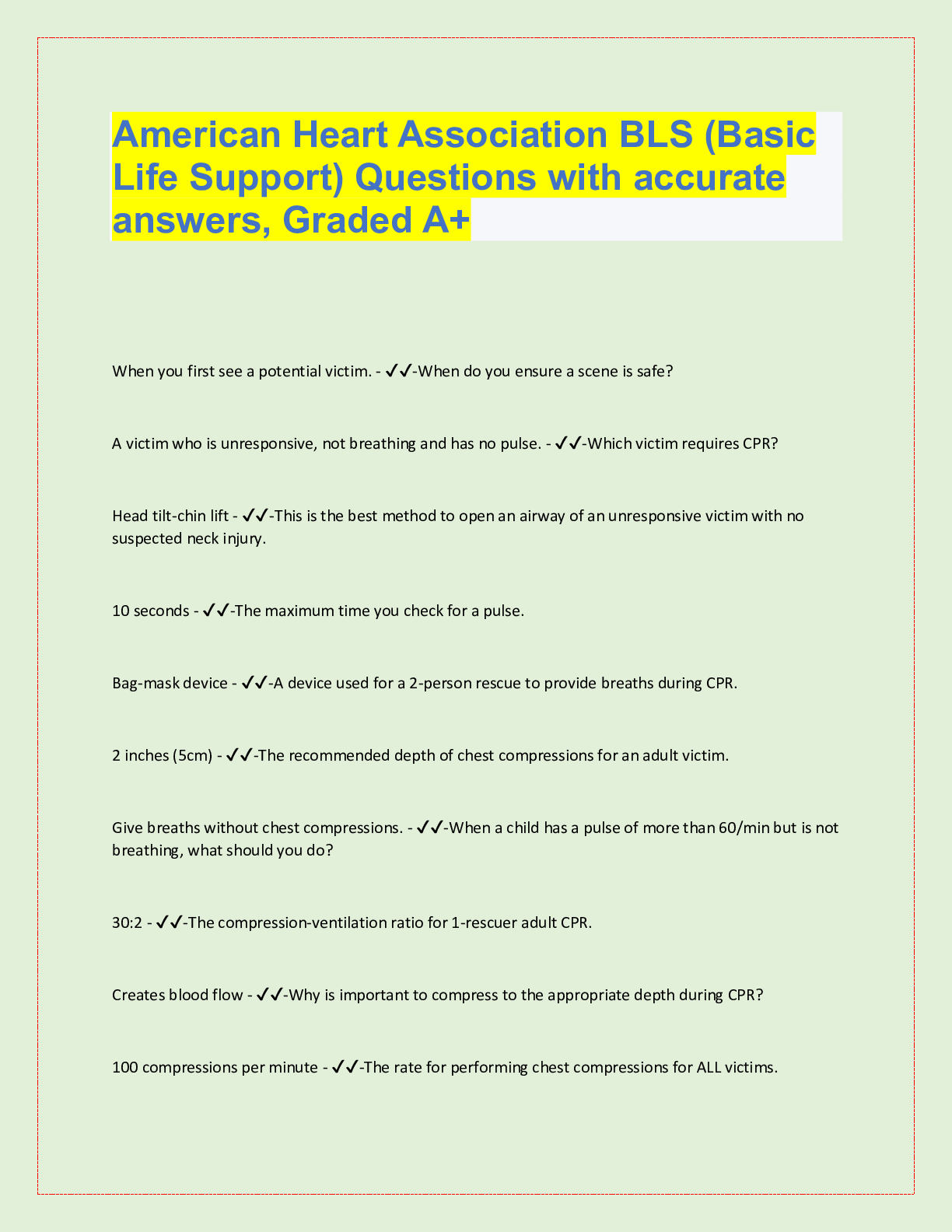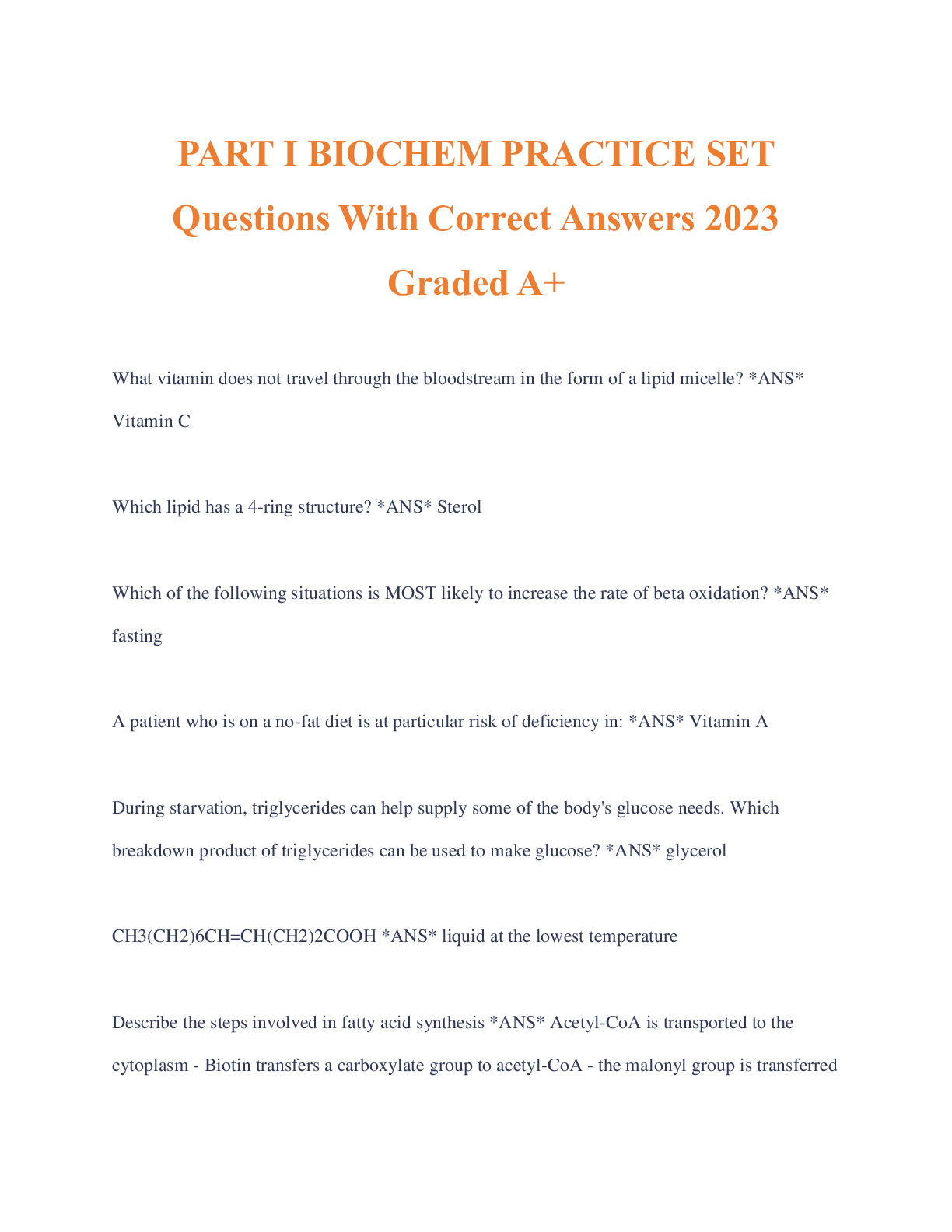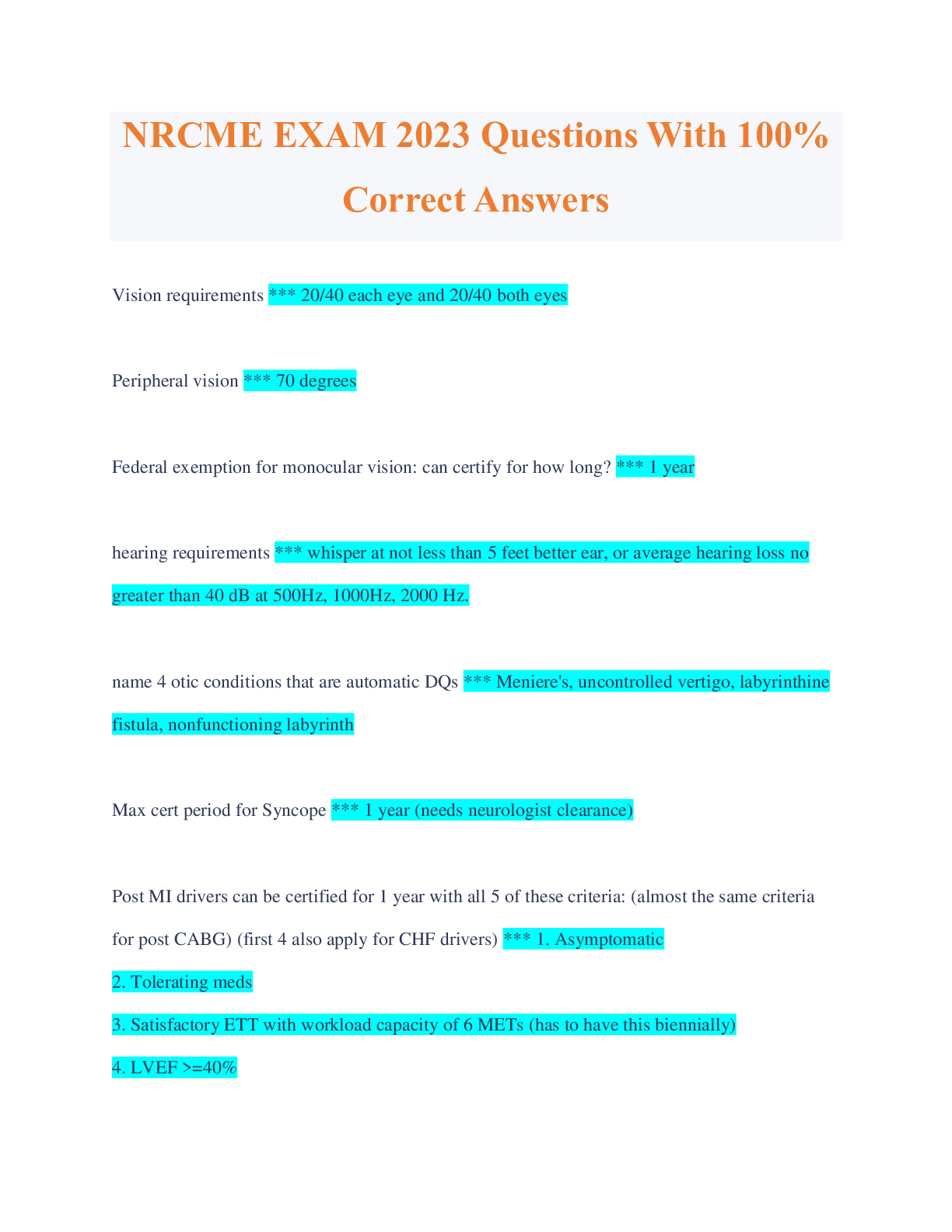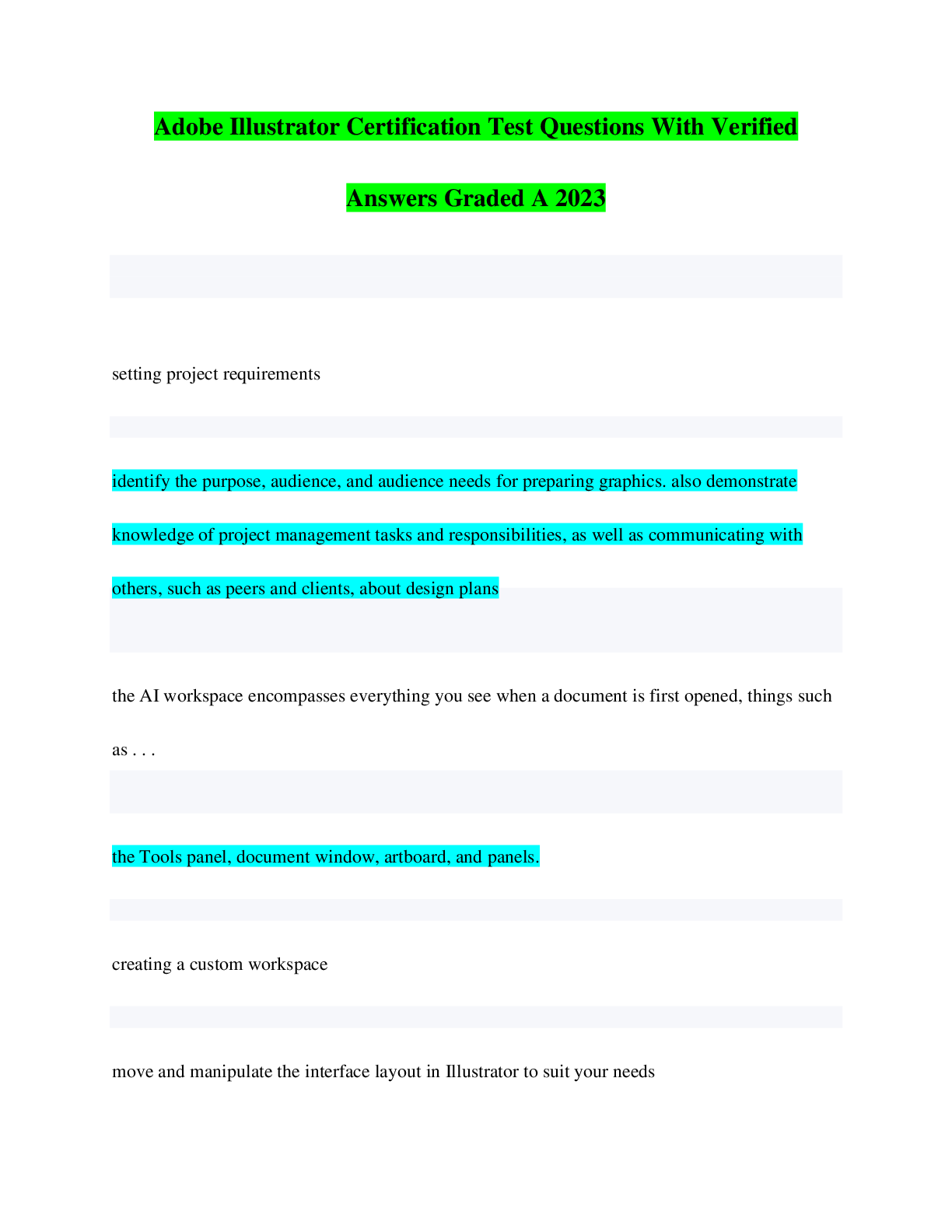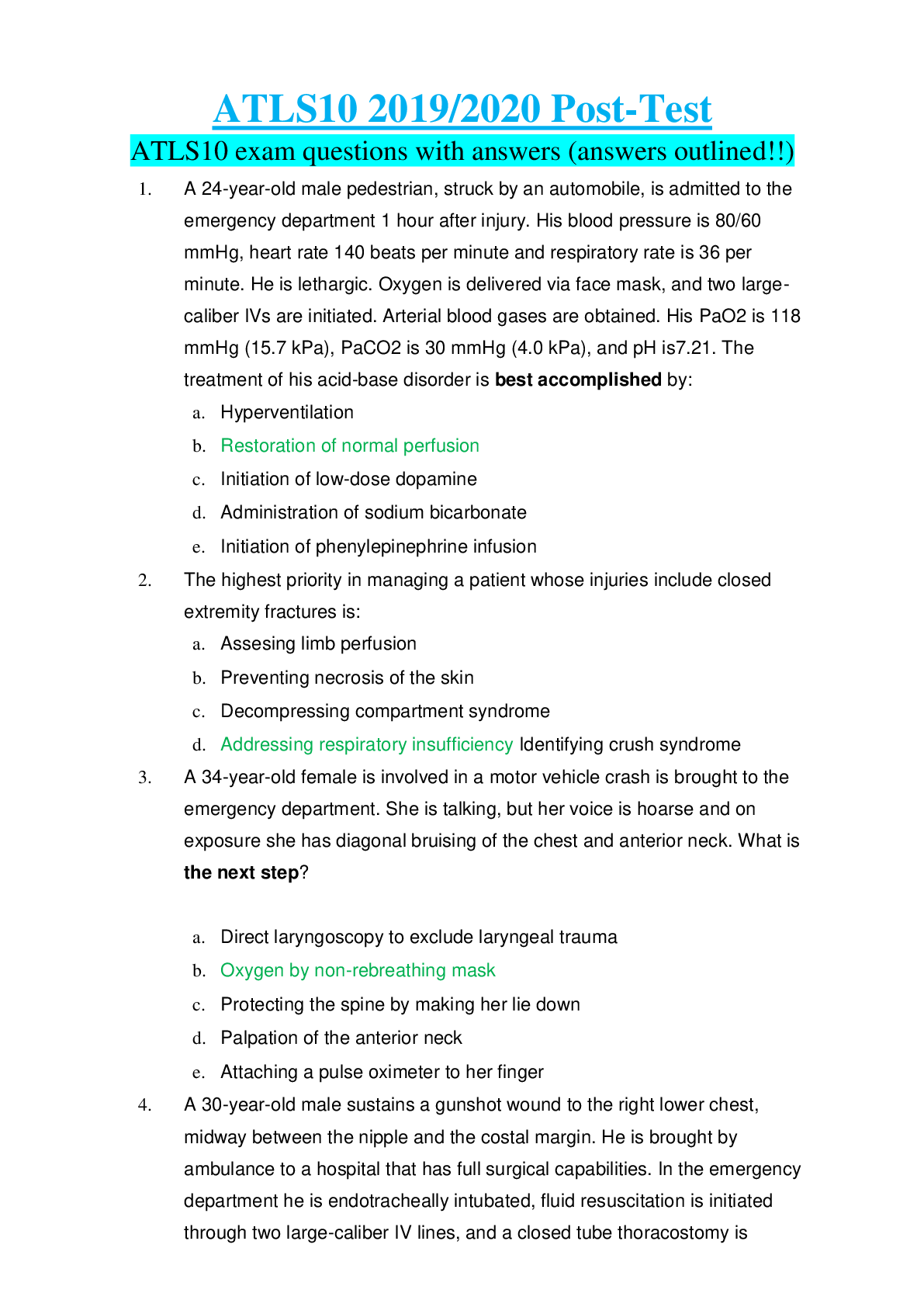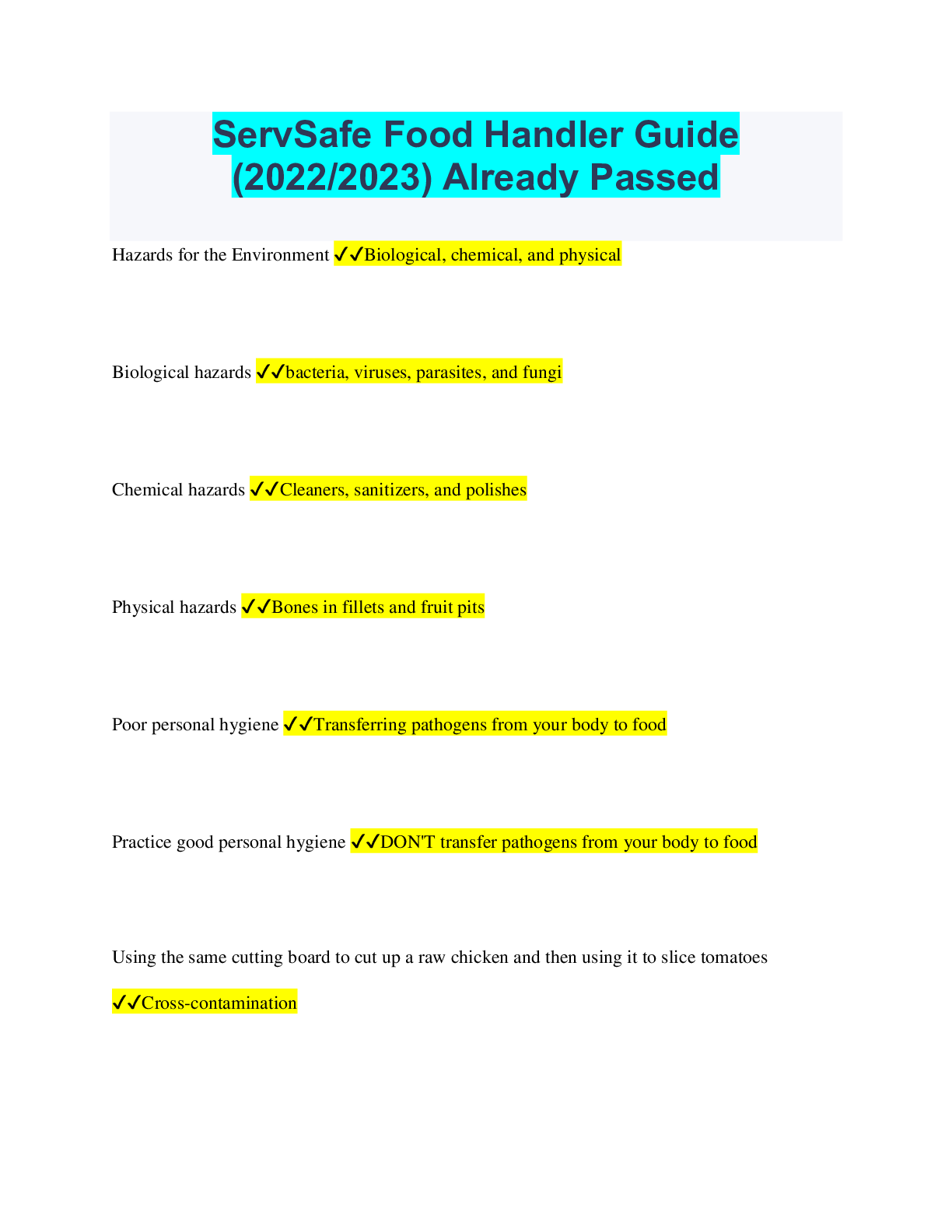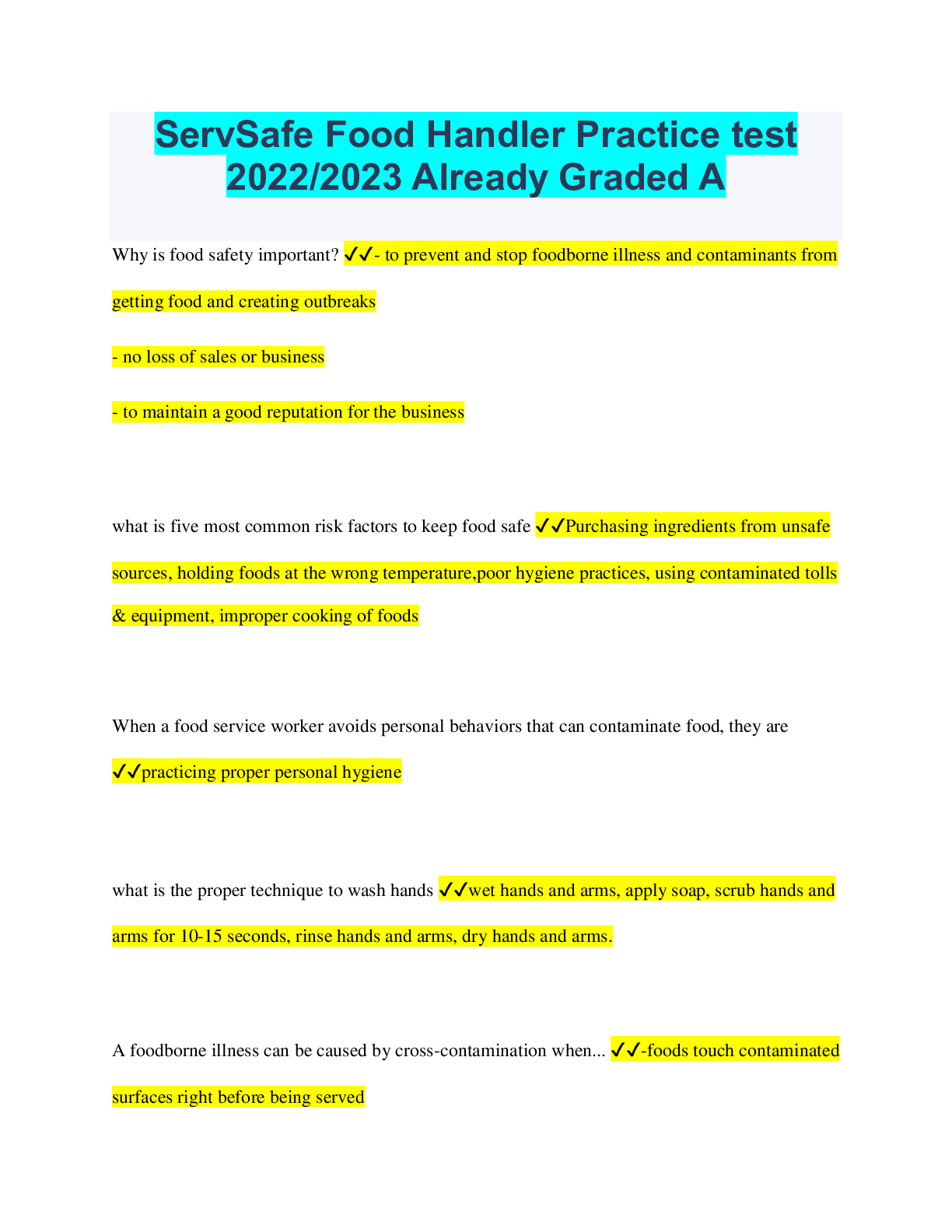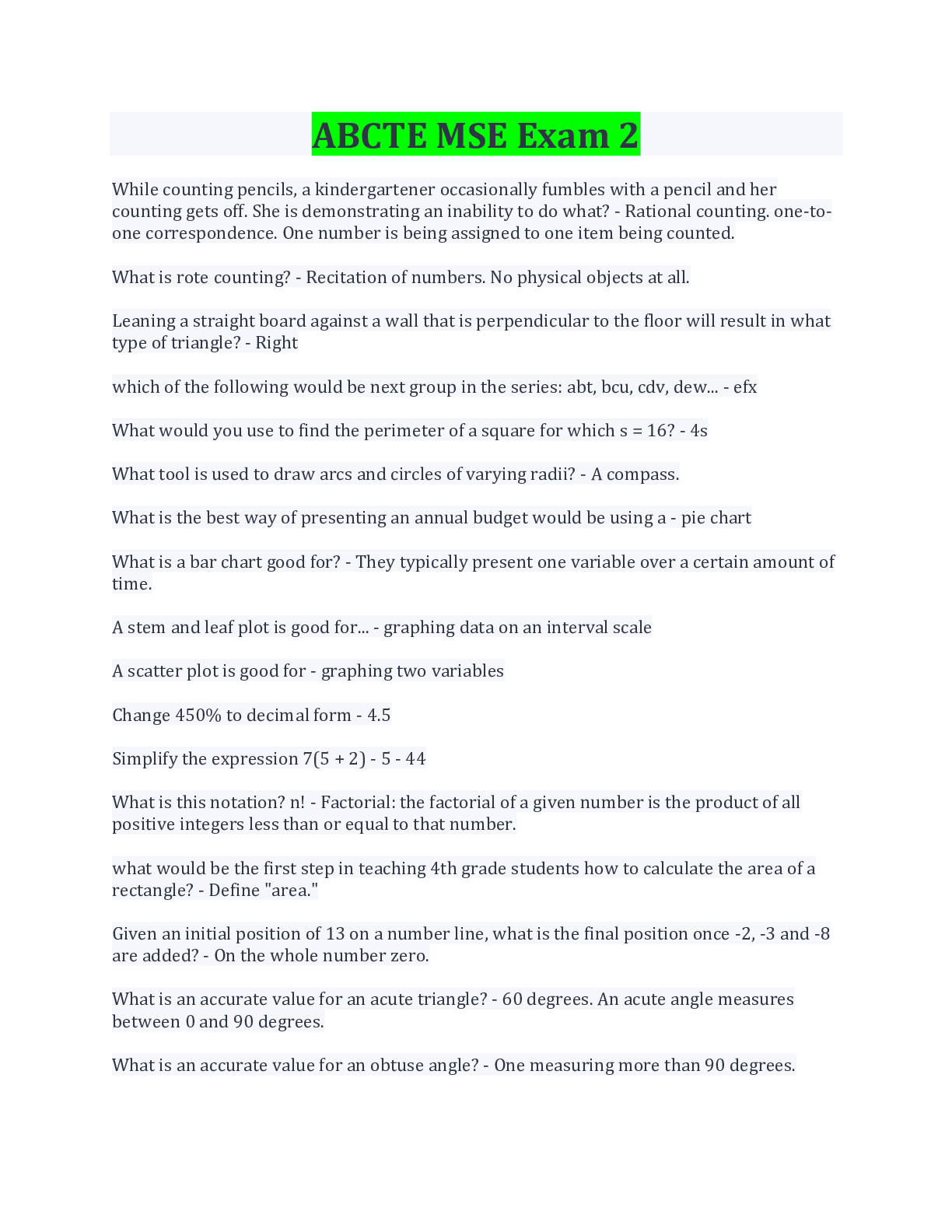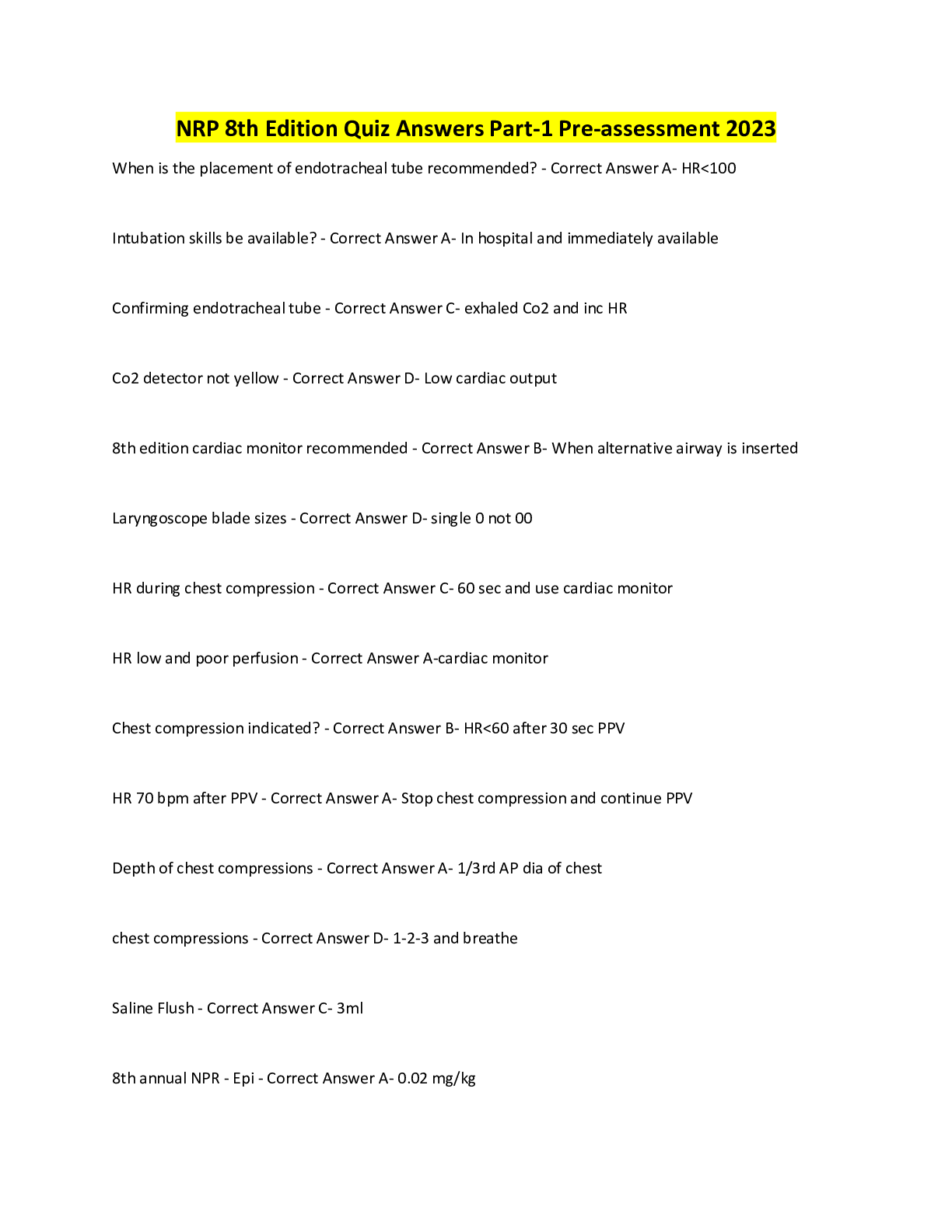*NURSING > QUESTIONS & ANSWERS > Practice frequently tested exam 153/153 questions with well detailed answers anew docs (All)
Practice frequently tested exam 153/153 questions with well detailed answers anew docs
Document Content and Description Below
Practice frequently tested exam 153/153 questions with well detailed answers anew docs Exam Name MULTIPLE CHOICE. Choose the one alternative that best completes the statement or answers... the question. 1) After becoming familiar with her local environment, a coyote learns to go to a specific stream for water when she is thirsty. She also tends to go to a particular shady area when the temperature is hot. These behaviours are best considered as examples of _. A) personal adaptation B) species capability C) stimulus response D) avoidance conditioning 2) Psychologists define the general process by which experience produces a relatively enduring change in behaviour or capabilities as _. A) extinction B) learning C) adaptive significance D) habituation 1) 2) 3) Within the field of psychology, _ focused on how organisms learn by assuming 3) there are general laws of learning that apply to virtually all organisms. A) Freudian psychologists B) behaviourists C) ethologists D) neurobiologists 4) A change in behaviour that results merely from repeated exposure to a stimulus is called ________, whereas involves learning associations between events. A) conditioning; habituation B) habituation; conditioning C) adapting; habituation D) habituation; adapting 4) 5) The decreasing response to a repeated stimulus is defined as ________. 5) A) extinction B) habituation C) latent learning D) sensitization 6) If we responded continuously to every stimulus in the environment we would quickly become fatigued and overwhelmed which means that has strong adaptive significance. A) extinction B) habituation C) sensitization D) one-trial learning 7) Habituation has because it allows organisms to learn NOT to respond to ________ stimuli. A) a low response cost; novel B) strong adaptive significance; uneventful and familiar C) extinction value; changing D) high secondary reinforcement value; discriminative 8) Which of the following provides the best definition of sensitization? It is a(n) ________ stimulus. A) continuous response to a discriminative B) increase in the strength of response to a repeated C) decrease in the strength of response to a repeated D) acquisition of a response to an increasing s 9) Tyler wakes up to a noisy drilling machine from the neighbour's house. He is unable to concentrate on his work from the disturbing loud drilling. As the day goes by, he is able to do his work despite the noise from the drilling machine being as loud as it was when it started. Tyler has _. A) given up B) become ignorant of the noise C) got habituated to the noise D) got sensitized to the noise 6) 7) 8) 9) 10) The organism learns to associate two stimuli such that a previously neutral stimulus comes to produce a reflexive response that was previously produced by a different stimulus, in _. A) modelling B) shaping C) operant conditioning D) classical conditioning 11) Terry smiles to himself each time he drives past the restaurant where he proposed to Lisa, now his wife of several years. Terry's pleasant emotions associated with the restaurant are an example of _. A) operant conditioning B) classical conditioning C) higher-order conditioning D) the law of effect 12) Probably the most important contribution of Ivan Pavlov's work with dogs was that it ________. A) illustrated the nature of the digestive process B) showed how fixed action patterns can be modified C) provided valuable insight into the nature of learning D) disproved prior operant conditioning theories 13) While conducting research on dog's salivary glands and digestion, Pavlov found that after numerous trials dogs _. A) salivated before food was presented to them B) associated salivating with being placed in the apparatus C) salivated only when the food was hard but not when the food was soft D) salivated after food was presented to them 10) 11) 12) 13) 14) If a tone is presented immediately before food, dogs will learn to salivate ________. 14) A) after the tone is presented and when footsteps are heard B) when the food is presented C) when the tone is heard D) at all times 15) A response, such as salivation, is automatically triggered when a stimulus has been associated with an impending important event, and is known as a response. A) physiological and reflexive B) chemical C) physiological D) reflexive 16) A reflexive or innate response that is elicited by a stimulus without prior learning is a(n) ________. A) unconditioned response (UCR) B) conditioned stimulus (CS) C) unconditioned stimulus (UCS) D) conditioned response (CR) 17) The period in classical conditioning during which a response is being learned is called ________. A) extinction B) acquisition C) spontaneous recovery D) adaptation 18) Before pairing an unconditioned stimulus (UCS) with a conditioned stimulus (CS), the CS is considered a(n) _. A) eliciting stimulus B) significant stimulus C) eliciting response D) neutral stimulus 19) All of the following would strengthen the classical conditioning process, EXCEPT ________. A) presenting a particularly strong UCS B) presenting the UCS before the CS C) repeatedly presenting the CS-UCS pairings D) making sure the time interval between the CS and UCS is short 15) 16) 17) 18) 19) 20) Under which of the following CS-UCS pairing conditions does learning usually occur most quickly? A) forward trace pairing B) forward short-delay pairing C) backward pairing D) simultaneous pairing 21) Learning is typically SLOWEST under which of the following CS-UCS pairings? ________ pairing. A) Backward B) Simultaneous C) Forward short-delay D) Forward trace 22) In a classical conditioning experiment that is utilizing backward pairing, the is presented the UCS. A) CR; at the same time as B) CR; after C) UCR; before D) CS; after 23) In classical conditioning experiments, learning is typically fastest when the UCS is ________ and the time interval between the CS and the UCS is _. A) similar to the CS; short B) more intense; zero C) more intense; short D) less intense; somewhat long 24) When the CS is presented repeatedly without the UCS, the CR will gradually weaken in a process called _. A) negative reinforcement B) discrimination C) habituation D) extinction 20) 21) 22) 23) 24) 25) The key factor in determining whether or not extinction will occur is _ . 25) A) the repeated presentation of the CS without the UCS B) whether punishment has been used during the learning trials or not C) the passage of time D) the use of a CS that readily lends itself to habituation 26) During the process of extinction, it is not uncommon for a CR to recur if, after a period of time has passed, the CS is presented again. This is known as recovery. A) automatic B) natural C) secondary D) spontaneous 27) Although Cathy had successfully extinguished the association between unknown cars and fear for over a month, when she saw an unfamiliar car on her street, she felt fear again. This is an example of _. A) recovered conditioning B) spontaneous conditioning C) recovered acquisition D) spontaneous recovery 28) When a dog salivates in response to a tone, the salivation would technically be 26) 27) 28) considered a(n) _ _. A) UCS B) UCR C) CR D) CS 29) The unconditioned stimulus and the unconditioned response are similar in that they both 29) are concerned with _ _. A) reflexive behaviours that have to be taught or learned B) important parts of operant conditioning C) behaviours that do not have to be learned or taught D) voluntary behaviours that have to be taught or learned 30) One major way that the CS and UCS are similar is that ________. 30) A) after classical conditioning, they both elicit the same behavioural response B) they both make the behaviours that they follow more likely to occur C) they both make the behaviours that they follow less likely to occur D) before classical conditioning, they both elicit the same behavioural response 31) On her 12th birthday, Juanita ate cake and then felt nauseous due to the flu. Since then, Juanita begins to feel sick whenever she sees a cake. Juanita also feels sick whenever she sees cupcakes or cookies. The CS has to the other treats. A) acquired B) discriminated C) generalized D) spontaneously recovered 31) 32) In classical conditioning, discrimination refers to how a A) UCS can become a CS B) CR is triggered by one stimulus but not by others ______. 32) C) CR can fade when a CS is repeatedly presented without the UCS D) CR can be triggered by many different stimuli 33) Stuart has a rather unusual fear . He is afraid of public speaking, but only when 33) he has to make speeches on the weekend. He is a professor and has no trouble speaking in front of large groups of students, and he has made effective presentations at conferences, as long as he presents on a weekday. The specificity of Stuart's fear most clearly demonstrates the process of _. A) avoidance conditioning B) discrimination C) stimulus generalization D) escape conditioning 34) If a CR has high stimulus generalization, then it will be triggered by ________ stimuli(us), whereas if it has high discrimination, it will occur in response to ________ stimuli(us). A) a neutral; a discriminative B) several different; a single C) a discriminative; a neutral D) a single; several different 34) 35) A neutral stimulus becomes a CS after being paired with an already established CS during _. A) extinction B) higher-order conditioning C) latent learning D) shaping 35) 36) Which of the following correctly describes higher-order conditioning? A ________. 36) A) CS is presented repeatedly without the UCS B) neutral response becomes a CR after being paired with an established CR C) neutral stimulus becomes a CS after being paired with an established CS D) CS becomes a neutral stimulus after being paired with an established CS 37) A smart political candidate becomes friends with a very popular professional baseball player because she hopes that this will improve her popularity with the voters. With regard to classical conditioning principles, the professional baseball player would best be viewed as a(n) _. A) UCR B) neutral stimulus C) CR D) already established CS 38) Susanne developed a fear of cars after being in a crash. Using the principles of classical conditioning, the crash would be considered the _. The fact that Susanne was fearful of all cars and not just the type that was in the crash demonstrates _ . A) UCS; discrimination B) UCR; stimulus generalization C) UCS; stimulus generalization D) UCR; discrimination 39) Raj is training his puppy to fetch a rubber bone each time it is thrown afar, and Raj says "go." The puppy will learn to fetch the bone most quickly with _. A) simultaneous pairing B) backward pairing C) forward trace pairing D) forward short-delay pairing 37) 38) 39) 40) A few days ago, Wendy got a speeding ticket on a highway behind Superior College. This morning, on her way to College, on the same stretch of the road where she had received the speeding ticket, Wendy immediately slowed down and checked her speedometer when she saw the flashing lights of a security vehicle. The security vehicle reminded her of the police car from the day she got the ticket. This is an example of ________. A) stimulus generalization B) stimulus discrimination C) extinction D) spontaneous recovery TRUE/FALSE. Write 'T' if the statement is true and 'F' if the statement is false. 41) Higher-order conditioning occurs when a neutral stimulus is paired repeatedly with an already established CS. MULTIPLE CHOICE. Choose the one alternative that best completes the statement or answers the question. 42) John Watson and Rosalie Rayner (1920) conducted experiments with an 11-month-old baby named Albert. Knowing that Albert would be afraid of loud noises, they conditioned him to fear a white rat by pairing the presentation of the rat with a loud noise. Although he was initially unafraid of the rat, after several trials, he would cry and become fearful when shown the rat. In this instance, the rat represented the _. A) UCS B) CR C) CS D) UCR 43) John Watson and Rosalie Rayner (1920) conditioned baby Albert to fear a white rat by pairing it with a loud noise that Albert already feared. After the conditioning had taken place, the researchers also found that Albert was afraid of furry white and grey objects, such as a rabbit and a Santa Claus mask. The fact that Albert was afraid of these additional items demonstrated that _. A) extinction had occurred B) higher-order conditioning had occurred C) discrimination had occurred D) stimulus generalization had occurred 40) 41) 42) 43) 44) Mary Cover Jones was a psychologist who was knowledgeable about behaviourist principles. Using the assumption that fear can be classically conditioned, she set out to break the CS-UCS pairing using a technique in which a patient is exposed to a stimulus that arouses anxiety without the presence of the UCS. The modern version of her technique was called _. A) systematic desensitization B) flooding techniques C) exposure therapies D) extinction therapies 45) Leah has a mild fear of heights. In order to deal with her anxiety, Leah goes to a park and practices walking closer to and eventually over a scary suspension bridge. She brings a friend along with her to distract and talk to her. After a few hours of gradual practice, Leah finds that she can go on the bridge without experiencing very much anxiety. Leah's new behaviour is most relevant to which of the following? A) fixed ratio schedules of reinforcement B) exposure therapy C) avoidance conditioning D) discrimination 46) The goal of exposure therapies is to expose a phobic person to the feared stimulus (CS) without the ________, so that the process of can occur. A) UCS; generalization B) UCS; extinction C) CR; extinction D) NS; habituation 47) Research on aversion therapy has yielded mixed results, because the changes produced are often _. A) short-term and extinguish over time B) adaptively significant C) the product of a fixed action pattern D) long-term and generalize well 44) 45) 46) 47) 48) Attempts to condition an aversion to a stimulus that triggers unwanted behaviour by pairing it with a noxious UCS is called therapy. A) extinction therapy B) exposure C) noxious D) aversion 49) Much of organisms' behaviours are influenced in subtle ways by classical conditioning. Classical conditioning can NOT influence _. A) approval B) arousal C) aversion D) attraction 50) Pat is attracted to Toby and they made a date for Friday night. However, when Pat picked Toby up, Toby was wearing a shirt very similar to one that Pat's ex-partner used to wear. 48) 49) 50) Pat felt immediately less attracted to Toby. Toby's shirt acted as a(n) and produced a CR. for Pat A) conditioned stimulus (CS) B) unconditioned stimulus (UCS) C) unconditioned response (UCR) D) conditioned response (CR) 51) Recent advances in computer and video technology have presented an innovative approach to treating anxiety disorders like phobias _. A) by creating aversive stimuli specific to each client B) by presenting virtual stimuli for exposure therapy within a virtual world C) with the presentation of virtual relaxation environments to reduce anxiety D) by providing 'on-call' virtual psychologists who are holographs created by computer software 52) Advertisers use the principles of classical conditioning to try to sell products. By pairing attractive and famous people, humour, or "warm-fuzzy" family images to products such as cars, food, and even telephone services, advertisers attempt to shift the public's attitude about the product. In these examples, attractive and famous people, humour, and family images are the ________, whereas the product being sold is the _. A) UCS; CS B) CS; UCS C) CR; UCR D) CS; UCR 51) 52) 53) Amanda is allergic to pollen. Whenever she is near a flower, she has an extreme allergic reaction. Interestingly, whenever Amanda is near a silk or fake flower, she also has an extreme allergic reaction despite the absence of pollen. In this example, the fake flower 53) is the and the allergic reaction it causes is the _ response. A) conditioned stimulus; conditioned B) conditioned stimulus; unconditioned C) stimulus generalization; conditioned D) unconditioned stimulus; conditioned 54) Roger, who is being treated for alcoholism, is given a medication that makes Roger nauseated when he consumes alcohol. Roger's therapist is creating an aversion for 54) alcohol in Roger by using _. A) repulsive therapy B) aversion therapy C) noxious therapy D) aversive-behaviour therapy 55) Operant conditioning is concerned with , whereas classical conditioning focuses on _. A) discriminative stimuli; generalized stimuli B) generalized stimuli; discriminative stimuli C) emitted behaviours; elicited behaviours D) elicited behaviours; emitted behaviours 55) 56) An organism learns an association between two stimuli in conditioning, 56) whereas an association between a behaviour and its consequence is learned in conditioning. A) classical; operant B) classical; higher-order C) operant; classical D) higher-order; classical 57) Edward Thorndike would most likely have given which of the following explanations for why cats could eventually escape his puzzle box? The cats(') _. A) eventually, were able to discriminate the CS sufficiently B) response cost for ineffective action eventually became too high C) used trial and error and slowly eliminated ineffective responses D) eventually gained insight into how to solve the problem 58) Kira is allowed to watch cartoons only after her homework has been completed and the assigned chores for the day are done. On days Kira's homework is unfinished, or chores are left undone, Kira is denied cartoon time. As a result, Kira has become responsible about what is expected of her. Kira's parents are using to shape her habits. A) punishment B) discriminative stimuli C) rewards D) the law of effect 59) One of the key differences between classical and operant conditioning is that in classical conditioning behaviour is , whereas in operant conditioning behaviour is ________. A) is considered to emitted; under the voluntary control of the organism B) under the physical control of the organism; triggered involuntarily like a reflex C) triggered involuntarily like a reflex; is considered to be elicited D) triggered involuntarily like a reflex; under the physical control of the organism 60) Edward Thorndike's law of specifically states that a response followed by a satisfying consequence will be more likely to occur. A) generalization B) instrumental learning C) aversive conditioning D) effect 57) 58) 59) 60) 61) In classical conditioning, a behaviour changes because of an association that is learned ________ the behaviour occurs, but in operant conditioning, the behaviour is influenced by events that occur it. A) before; after B) at the same time as; before C) after; before D) before; at the same time as 62) B.F. Skinner designed a special chamber in which recording the behaviours of rats was possible. Skinner recorded and studied the types of behaviours displayed by rats, the consequences of each behaviour, and the frequency of behavioural displays. This chamber was known as the _. A) Skinner box B) puzzle box C) rat puzzle box D) Skinner maze 63) Using his special chamber, Skinner found that rats would display a behaviour, such as pressing a lever, more frequently if a food pellet was provided following that behaviour. The food pellet acts as a(n) _. A) punisher B) outcome variable C) reinforcer D) strengthener 64) In the Skinner box, the behaviour of rats would in frequency if given food 61) 62) 63) 64) pellets and in frequency if given electric shocks. A) decrease; increase B) increase; increase C) increase; decrease D) decrease; decrease 65) According to operant conditioning, occurs when a consequence strengthens the behaviour it follows. A) reinforcement B) response cost punishment C) aversive punishment D) generalization 65) 66) In operant conditioning, punishment refers to any ________ that the likelihood of a behaviour. A) response; increases B) stimulus; increases C) consequence; decreases D) discrimination; decreases 67) You give your well-trained dog the command, "Roll over!" She immediately does and you give her a tasty dog treat. According to B.F. Skinner, your command would be considered the _. A) negative reinforcer B) conditioned stimulus C) antecedent stimulus D) positive reinforcer 66) 67) 68) An antecedent is a(n) displayed. that is present a given behaviour has been 68) A) conditioned response; after B) emitted behaviour; before C) stimulus; before D) association; after 69) Shelley has noticed that if her dad is in good mood, he will usually praise her for working on her homework in the evening. If he isn't in a good mood, he does not praise her. Relative to the principles of operant conditioning, the mood of Shelley's dad would be considered a(n) , signalling when he will praise her for her homework. A) consequence B) conditioned stimulus C) behaviour D) antecedent 70) When you tell your dog, "Sit," and she does, you almost always give her a small treat. In this example, which of the following would be considered a discriminative stimulus? The _. A) association between sitting and the small treat B) small treat C) command "sit" D) behaviour of sitting 69) 70) 71) Children in a gymnastics class do many exercises, including some exercises that are done on individual mats. When the instructor blows a whistle twice, the children bring their mats and spread them in neat rows on the floor. The instructor's blowing the whistle 71) twice is _ __. A) stimulus discrimination B) the operant discriminator C) the discriminative stimulus D) the operant stimulus 72) When a response is strengthened by the subsequent presentation of a stimulus, this is called _. A) aversive punishment B) negative reinforcement C) positive punishment D) positive reinforcement 73) Tran volunteered to help her grandmother clean her house and do some yard work. Because of her assistance, Tran was given $20. She then volunteered to come again the 72) 73) following week. This is an example of _. A) positive reinforcement B) negative reinforcement C) conditional reinforcement D) aversive punishment 74) Last week, Jessica threw a temper tantrum in the middle of the grocery store because her mother had said she could not have a candy bar. After 5 minutes of screaming and crying, Jessica got a candy bar. Now Jessica is throwing another temper tantrum in the grocery store because she was told that she could not have an ice cream cone. The 74) frequency of Jessica's behaviour has been influenced by . A) negative reinforcement B) aversive punishment C) response cost punishment D) positive reinforcement 75) When a response increases in frequency by the subsequent removal (or avoidance) of a stimulus, it is called _. A) negative reinforcement B) response cost punishment C) positive reinforcement D) aversive punishment 75) 76) In negative reinforcement, when an aversive stimulus is , it makes the behaviour that it follows likely to occur. A) presented; more B) removed; less C) removed; more D) presented; less 77) Mark just broke up with Deborah. He used to see Deborah every day at 11:30 between classes but he decides to take an alternative route so that he won't have to feel bad when he sees her. Having successfully avoided the negative feelings from seeing Deborah, he 76) 77) now takes the alternate route every day. This is an example of _ . A) positive reinforcement B) positive punishment C) response cost punishment D) negative reinforcement 78) One similarity between punishment and operant extinction is that both _ A) involve the withdrawal of an aversive consequence B) can be used to increase the likelihood of a behaviour C) can be used to reduce the likelihood of a behaviour D) involve the presentation of a positive consequence _. 78) 79) Aversive punishment refers to the process in which a behaviour is by the subsequent of a consequence. A) strengthened; presentation B) weakened; removal C) weakened; presentation D) strengthened; removal 80) Operant extinction, aversive punishment, and response cost punishment are similar in that they all _. A) involve the manipulation of positive reinforcers B) serve to weaken behaviour C) involve the manipulation of negative reinforcers D) serve to strengthen behaviour 79) 80) 81) Which of the following illustrates aversive (positive) punishment? 81) A) A man puts on his seat belt in order to stop the annoying warning bell in his car. B) Parents pay their daughter for getting good grades. C) A boy loses his TV privileges after lying to his parents. D) An owner angrily scolds his dog after she chews up a sock. 82) Response cost punishment involves which of the following? 82) A) Taking away something positive in order to strengthen a behaviour. B) Presenting something positive in order to strengthen a behaviour. C) Taking away something positive in order to weaken a behaviour. D) Presenting something negative in order to weaken a behaviour. 83) One way that operant extinction and response cost punishment are similar is that they both involve _. A) consequences that strengthen behaviours B) the cessation or removal of something C) the presentation of something D) stimuli that signal when a consequence will follow a behaviour 84) One of the disadvantages of is that it often arouses negative emotions such as fear and anger and can inspire the dislike or avoidance of the person administering it. A) negative reinforcement B) aversive punishment C) secondary reinforcement D) higher-order conditioning 83) 84) 85) A teenager refrains from using profanity when she is around her parents, who ground her when she swears, but when her parents aren't around, she often uses "bad language." This example demonstrates a limitation of because the suppression of the undesired behaviour to other relevant situations. A) antecedents; doesn't generalize B) punishment; doesn't generalize C) negative reinforcement; doesn't generalize D) negative reinforcement; inadvertently generalizes 86) Todd yells at his brother and takes his toy away. Todd's mom sees his behaviour and gives Todd a scolding. This is an example of _. A) aversive punishment B) contingency punishment C) response cost punishment D) negative reinforcement 87) The process in which a response decreases the frequency of a behaviour by the subsequent removal of a stimulus is called _. A) aversive punishment B) response cost punishment C) negative reinforcement D) contingency punishment 88) To assist Janice to stop smoking, she has made a contract with her closest friends. If anyone catches Janice smoking, she must pay that person $5.00 on the spot. This is an example of _. A) contingency punishment B) negative reinforcement C) response cost punishment D) aversive punishment 85) 86) 87) 88) 89) While walking through the mall, a young boy sees a new pair of shoes and immediately tells his grandmother that he would like to have them. The grandma initially refuses, prompting the boy to get upset and he starts to cry. The grandma hates to see her grandson get upset, so she changes her mind and buys him the shoes. In this example, we could say that the grandma's initial refusal was and the boy's mini-tantrum was ________. A) classically extinguished; extinguished via operant conditioning B) the consequence; the discriminative stimulus C) the conditioned stimulus; the conditioned response D) aversively punished; positively reinforced 89) 90) Generally, reinforcement that immediately follows a behaviour has reinforcement is delayed following a behaviour. A) no effect B) a stronger effect than C) a weaker effect than D) the same effect as _ when 90) 91) Generally, punishment that immediately follows a behaviour has when punishment is delayed following a behaviour. A) no effect B) a weaker effect than C) a stronger effect than D) the same effect as 92) The fact that people can become more easily addicted to drugs that produce their effects quickly is most relevant to which of the following? A) shaping B) the nature of withdrawal C) the effect of immediate reinforcement D) stimulus generalization 91) 92) 93) On a rainy day Sally wears rubber boots to prevent her feet from getting wet. Preventing her feet from getting wet is a _. A) positive punishment B) negative reinforcer C) positive reinforcer D) negative punishment 94) Randy fights with his younger brother Paul over a new toy. Their parents take the toy away from the boys and the fighting decreases. Randy and Paul's parents are using ________ to lessen the fighting. A) negative reinforcement B) positive punishment C) negative punishment D) positive reinforcement 93) 94) 95) Shaping is defined as the process in which ________. 95) A) a neutral stimuli becomes a "reinforcer" because of its association with a primary reinforcer B) successive approximations of a desired behaviour are reinforced C) a behaviour is strengthened by the presentation of a consequence D) a behaviour is weakened by the removal of a consequence 96) Bobby's parents are frustrated because he never cleans his room. In order to modify their son's behaviour, they start reinforcing (with 25 cents) every time he simply throws his clothes into a particular corner instead of all around the room. After some time passes, they only reinforce him if he puts his clothes in the hamper. As this process continues, Bobby's parents gradually keep changing the terms of reinforcement so that Bobby has to do more and more of the tasks required to keep his room clean. After several months of this, Bobby cleans his entire room for the same 25-cent reward. This example best demonstrates the process of _. A) reinforced extinction B) higher-order reinforcement C) shaping D) chaining 96) 97) The behavioural technique, developed by B.F. Skinner, which involves reinforcing successive approximations toward a final response, is called _. A) training B) behaviour modification C) chaining D) shaping 98) Harpreet wants to train her dog, Jupiter, to walk to the television and turn it on with her nose. Harpreet begins the training by rewarding Jupiter whenever he takes a step into the living room. Next, Harpreet rewards Jupiter only when he walks in the direction of the television. Then Harpreet rewards Jupiter only when he walks to the television, and finally she rewards Jupiter only when he touches the power button with his paw and turns on the television. The behavioural technique that Harpreet is using to train her dog 97) 98) is called _ _. A) behaviour modification B) approximate reinforcement C) shaping D) chaining 99) The behavioural procedure that is used to develop a sequence of responses by reinforcing each response with the opportunity to perform the next response is called _. A) training B) chaining C) successive approximations D) shaping 100) Jackson, a dog, has learned that when he wants to go and chase birds in the backyard, he has to stand in front of the back porch door until his owner lets him out. Recently, Jackson's owner, Ismael, added an inner door to gain access to the back porch. Jackson must now push the inner door open, to be reinforced by the chance to stand at the back door, where his owner will open the door and let him out to chase birds. This behavioural process is called _. A) behavioural modification B) shaping C) chaining D) successive approximations 99) 100) 101) The use of shaping and chaining ________. 101) A) influences all organisms' behaviours B) is restricted to training animals and does not account for human behaviours C) does not account for human behaviours D) is restricted to training animals 102) Your dog has learned that whenever her food bowl is on the floor in your house, if she walks over and looks in it there will be food in it. While visiting some friends, your dog notices a similar looking bowl on the floor, so she runs over to it expecting to find some food in it. This example is most relevant to which of the following concepts? A) operant discrimination B) classical extinction C) operant generalization D) higher-order conditioning 102) 103) When a discriminative stimuli influences a behaviour, that behaviour ________. 103) A) is said to be under stimulus control B) illustrates operant generalization C) has been extinguished D) has been classically conditioned 104) When an operant response occurs to a new antecedent stimulus or situation that is similar 104) to the original one, _ _ has occurred. A) operant generalization B) stimulus control C) operant discrimination D) the schedule of reinforcement 105) Veronica is a 2-year-old who likes to explore her environment. However, this gets her into a lot of trouble. Veronica has learned to stop whatever she is doing if she hears her mom or dad say, "No!" Yesterday, Veronica was with a babysitter. When the babysitter said, "No!" to Veronica, she also stopped what she was doing. Veronica's behaviour demonstrates _. A) delayed consequences B) operant generalization C) negative reinforcement D) operant discrimination 106) A trained dolphin will only do a particular trick when the trainer gives a specific hand signal. When the trainer gives different hand signals, the dolphin does other tricks, thus illustrating that the dolphin's behaviour is under stimulus control. The dolphin's behaviour also best illustrates which of the following? A) operant discrimination B) higher-order conditioning C) avoidance conditioning D) positive reinforcement 107) If placed on a continuous reinforcement schedule, an animal will be reinforced after ________. A) a particular amount of time has passed B) some of the correct responses C) a particular number of correct responses D) every correct response 106) 107) 108) On a _ _ schedule, reinforcement is given after an inconstant number of correct 108) responses, all centred on an average. A) variable-interval B) variable-ratio C) fixed-interval D) fixed-ratio 109) The first correct response that occurs after a set amount of time is reinforced is following a schedule. A) variable-ratio B) fixed-ratio C) variable-interval D) fixed-interval 110) An instructor offers exams every 2 weeks throughout the term of her course. As a result, a sizeable percentage of the students in her class study very hard every 2 weeks and do little studying in between. This example is most similar to the partial reinforcement schedule of _. A) variable interval B) fixed interval C) fixed ratio D) variable ratio 109) 110) 111) Random drug tests and roadside speed traps would both be considered examples of the ________. A) fixed interval schedule B) variable interval schedule C) variable ratio schedule D) fixed ratio schedule 111) 112) Animals placed on a schedule of reinforcement often show a pause briefly 112) after being reinforced, possibly because they have learned that the next response is never reinforced. A) variable ratio or fixed ratio B) continuous C) fixed ratio or fixed interval D) variable interval 113) Researchers in the field of operant conditioning have learned that ________ reinforcement schedules are more resistant to extinction than reinforcement schedules. A) continuous; partial B) partial; continuous C) fixed; variable D) partial; variable 114) These schedules of reinforcement are more resistant to extinction because if reinforcement has been unpredictable in the past, it takes longer to learn that it has stopped altogether; they are known as schedules. A) continuous B) fixed C) variable D) primary 115) If a candy machine isn't working properly, we can usually figure it out pretty quickly and do not continue to deposit coins into the machine. Because these machines are supposed 113) 114) 115) to operate on a _ working properly. _ schedule, it is easier for people to tell when they are not A) variable ratio B) variable interval C) fixed interval D) continuous 116) Which of the following would be most likely to produce the fastest learning that is also resistant to extinction? Start with _. A) continuous reinforcement and then shift to a fixed reinforcement schedule once the behaviour has been learned B) a variable reinforcement schedule and then shift to a continuous reinforcement schedule once the behaviour has been learned C) continuous reinforcement and then shift to a variable reinforcement schedule once the behaviour has been learned D) a fixed reinforcement schedule and then shift to a variable reinforcement schedule once the behaviour has been learned 117) Carlos works as a packer at an apple orchard. His rate of pay is based on the number of boxes he packs in an hour. Carlos gets paid on a schedule. A) variable-interval (VI) B) fixed-interval (FI) C) variable-ratio (VR) D) fixed-ratio (FR) 118) When an organism learns to prevent exposure to an aversive stimulus altogether, ________ conditioning is said to occur. A) higher-order B) classical C) escape D) avoidance 119) According to the two-factor theory of avoidance learning, phobias are created through ________ but are maintained through _. A) positive reinforcement; negative reinforcement B) stimulus discrimination; stimulus control C) operant conditioning; observational learning D) classical conditioning; operant conditioning 116) 117) 118) 119) 120) Once an avoidance response has been learned, it usually ________. 120) A) extinguishes very quickly if we quit reinforcing it B) is very difficult to extinguish, even when aversive consequences have been removed C) extinguishes very quickly if we have used a variable reinforcement schedule to create it D) is very difficult to extinguish if we used a continuous reinforcement schedule to create it 121) After a single bad encounter with a dog, a child develops a dog phobia. She shows strong avoidance and escape behaviours at the sight of a dog. Initially, the sight of a dog served as a conditioned stimulus that triggered fear. However, after operant conditioning has taken over and her avoidance behaviour has been learned, the sight of a dog would best be considered as an example of a(n) _. A) conditioned response B) unconditioned stimulus C) negative reinforcer D) antecedent stimulus 122) Computer-assisted instruction programs provide immediate feedback to people about their learning and allow people to learn at their own pace. These programs are most strongly associated with which of the following? A) stimulus generalization B) observational learning C) classical conditioning D) operant conditioning 123) A reinforcement system that utilizes such things as points or chips that can be redeemed 121) 122) 123) later for tangible rewards to reinforce desired behaviour is called . A) classical conditioning B) shaping C) latent learning D) a token economy 124) Police dogs that are used to locate illegal drugs, and pigeons that can peck a signal button when they spot an orange life jacket in the water, both demonstrate how the principles of ________ can be used to train animals to assist humans. A) operant conditioning B) observational learning C) higher-order conditioning D) classical conditioning 125) Behaviour modification combines a behavioural approach with the scientific method in order to solve individual and societal problems, it is also known as the scientific area of ________. A) applied behaviour analysis B) observational learning C) higher-order conditioning D) classical conditioning 126) Kelly's mother is training her to clean her room without being asked to do so. Each time Kelly cleans her room without a reminder her mother gives her a star. Kelly can exchange 5 stars to watch her favourite cartoon show. Kelly's mother is employing to train Kelly. A) escape conditioning B) reinforcement economies C) token economies D) avoidance conditioning 127) How animals appear to be biologically "prewired" to easily learn behaviours that are related to their survival as a species because of evolutionary forces is referred to by the term _. A) latent learning B) fixed action pattern C) operant extinction D) preparedness 124) 125) 126) 127) 128) The text discussed an experiment in which rats were exposed to X-rays that were paired with sweet water, a light, and a buzzer. The X-rays made the rats ill and the researchers wanted to know which stimuli would become associated with the illness. The results revealed that the rats avoided _. The findings from this experiment were used to demonstrate the concept of _. A) all three stimuli; discrimination B) only the light; latent learning C) only the sweet water; preparedness D) only the buzzer; negative reinforcement 129) In the anticipatory nausea and vomiting response that can occur with patients receiving cancer treatment, initially neutral stimuli, such as needles, the hospital, or the treatment room, become that trigger sickness. A) positive reinforcers B) discriminative stimuli C) conditioned stimuli D) negative reinforcers 130) An 11-year-old girl was suffering from a disease in which her own immune system attacked her body. To treat her, they first paired cod liver oil with an immune-suppressant drug. Later, when she only received pure cod liver oil, her immune system still showed the intended impairment. In this instance, the CS would be the ________. A) immune-suppressant drug B) immune system impairment triggered by the drug C) immune system impairment triggered by the cod liver oil D) cod liver oil 131) Tyler ate a big burger before a major dental surgical procedure. The pain from the procedure lasted a few days. Tyler has an aversion for burgers since his dental procedure, as burgers remind him of the pain he experienced on the day of the dental surgery. This 128) 129) 130) 131) conditioned response is called . A) reinforced taste reversal B) reinforced taste aversion C) conditioned taste reversal D) conditioned taste aversion TRUE/FALSE. Write 'T' if the statement is true and 'F' if the statement is false. 132) Conditioned taste aversions were discussed to demonstrate the concept of higher-order conditioning. MULTIPLE CHOICE. Choose the one alternative that best completes the statement or answers the question. 133) Research suggests that a person would be LEAST likely to develop a phobia of which of the following? A) snakes B) heights C) spiders D) guns 132) 133) 134) Which of the following is most strongly related to the concept of instinctive drift? 134) A) rats made ill by X-rays associated it with sweet water but not a light or buzzer B) a chicken being trained to play baseball reacted to the ball as if it were food C) rats that were shocked associated the shock with a buzzer and light but not a sweet taste D) a coyote learns to avoid sheep because ranchers have paired sheep meat with lithium chloride 135) What plays a key role in regulating our ability to experience reward? 135) A) amygdala B) neural pathways involving dopamine C) the thalamus D) neural pathways involving serotonin 136) How do psychologists know that the hypothalamus and neural pathways involving dopamine regulate the ability to experience reward? A) Humans are unable to report pleasure when specific areas in the hypothalamus are electrically stimulated. B) Rats will repeatedly press a lever to receive electrical stimulation in the areas of the hypothalamus and humans report pleasure when specific areas in the hypothalamus are electrically stimulated. C) Rats will refuse to repeatedly press a lever to receive electrical stimulation in the areas of the hypothalamus. D) Humans will pay unethical surgeons to have electrodes implanted to self-stimulate their hypothalamus. Answer: B Topic: 07 -22 Learning and the Brain LO: 07 -04 Biology and Learning 137) The researcher Rosenzweig (1984) found that young animals exposed to enriched learning environments with toys and greater opportunities to learn _. A) have reduced amounts of neural pruning B) are biologically predisposed to have larger brains with more neural connections C) are biologically predisposed to learn faster and with greater efficiency D) develop heavier brains with more dendrites and synapses 138) The fact that exposure to stimulating environments seems to the declines in cognitive functioning that usually occur in late adulthood best demonstrates how ________. A) have no effect on; biology influences learning B) slow down; learning influences biology C) slow down; biology influences learning D) have no effect on; learning influences biology 139) Lexy is a 2-year-old girl whose parents are constantly stimulating her with toys, games, puzzles, and books. We can expect Lexy's brain to have _. A) more dendrites but few synapses B) few dendrites and few synapses C) few dendrites but more synapses D) more dendrites and more synapses 136) 137) 138) 139) 140) According to learning theorists, insight involves the _ . 140) A) sudden perception of a useful relationship that helps to solve a problem B) identification of antecedent stimuli that indicate when a behaviour will have certain consequences C) positive reinforcement of a conditioned response on a variable schedule of reinforcement D) association of a previously neutral stimulus with an unconditioned stimulus 141) The model asserts that the key factor in classical conditioning is not how often the CS is paired with the UCS, but how well the CS predicts the appearance of the UCS. A) insight B) cognitive C) latent learning D) expectancy 142) Forward pairing (CS followed by UCS) typically produces the strongest learning; simultaneous pairing produces weaker learning; and backward pairing (UCS followed by CS) produces the weakest learning. This makes sense, based on _. A) insight B) the expectancy model C) latent learning D) cognition and awareness 143) Edward Tolman's research demonstrating that rats in a maze appeared to develop cognitive maps of the maze without receiving any reinforcement provided evidence most supportive of the concept of _. A) observational learning B) latent learning C) insight D) preparedness 144) For a traditional behaviourist, the most troubling aspects of Tolman's latent learning research with rats was that learning was happening without any _. A) awareness of contingencies B) direct reinforcement C) insight D) discriminative stimuli 141) 142) 143) 144) 145) Andy has cooked a delicious dish that he learnt a few weeks ago from watching his favourite television show on the food channel. He kept the recipe and the method in his mind from a few days ago until it was time to actually cook the dish, demonstrating ________. A) learning by insight B) instrumental learning C) latent learning D) classical conditioning 146) Amanda visits a foreign country with a culture very different from her culture. She observes her hosts when they greet people, and Amanda greets the natives in the same way she observed her hosts doing. Amanda has learnt this behaviour by observing her ________. A) role players B) models C) prototypes D) exemplars 147) The psychologist Albert Bandura, a prominent researcher of observational learning, 145) 146) 147) suggested that for organisms to learn from observation, they must first A) be attentive to the behaviour produced by the model B) have the ability to reproduce the behaviour C) have motivation to display the behaviour produced by the model D) recall the behaviour that was produced by the model ______. 148) The psychologist Albert Bandura identified a four-step process necessary for observational learning to occur. Which of the following is NOT one of the steps? A) reproduction B) motivation C) retention D) recollection 149) In Albert Bandura's "Bobo doll" experiment, children who saw a model being ________ 148) 149) for acting aggressively later performed with various toys. aggressive acts when placed in a room A) punished; more B) rewarded; no C) punished; fewer D) rewarded; fewer 150) A child notices and watches an adult who is able to do something that she can't yet do. This child's behaviour best illustrates which of the following steps in the modelling process? A) attention B) reproduction C) motivation D) retention 151) When Joyce N. Sprafkin and her fellow researchers (1975) investigated helping behaviour in children using Lassie and Brady Bunch television programs, they found ________. A) watching aggressive television led to aggressive behaviour in children B) watching prosocial modelling on a Lassie television program influenced children's subsequent helping behaviour in the experiment C) reading a prosocial Lassie storybook was more effective by 50% than watching a prosocial Lassie television program D) watching prosocial modelling on a Lassie television program influenced children's subsequent helping behaviour during school recess and after school in the playground 152) The Joyce Sprafkin research demonstrating that children who watched a prosocial Lassie TV program were more likely to engage in helpful behaviour was presented to illustrate which of the following? A) latent learning B) cognitive maps C) observational learning D) insight 153) Reena is raised by caring parents who go out of their way to help needy people. They volunteer their time regularly toward good causes. MOST likely, Reena will grow up to be _. A) prosocial B) complacent about helping others C) antisocial D) ignorant about helping others 150) 151) 152) 153) [Show More]
Last updated: 1 year ago
Preview 1 out of 34 pages
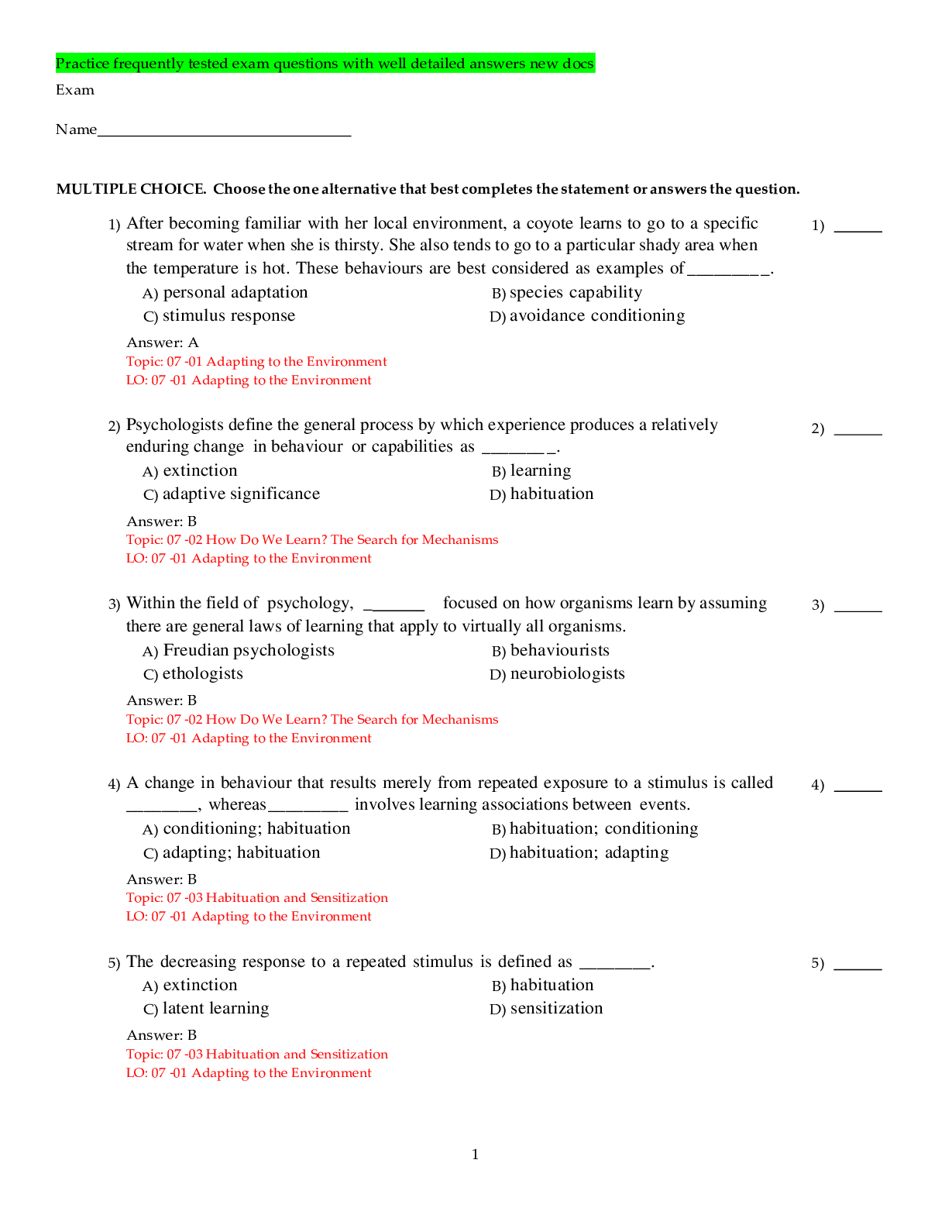
Reviews( 0 )
Document information
Connected school, study & course
About the document
Uploaded On
Dec 13, 2020
Number of pages
34
Written in
Additional information
This document has been written for:
Uploaded
Dec 13, 2020
Downloads
0
Views
53

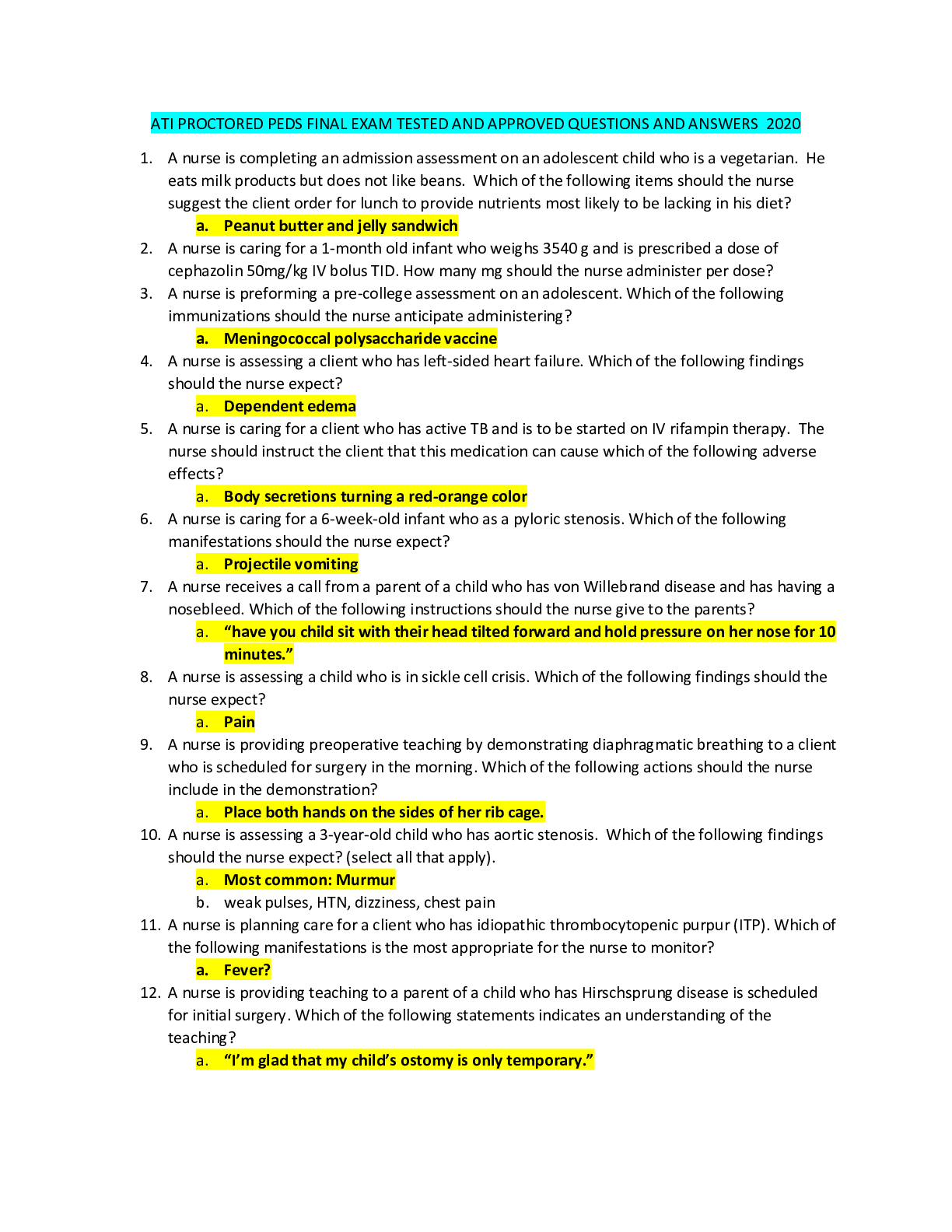
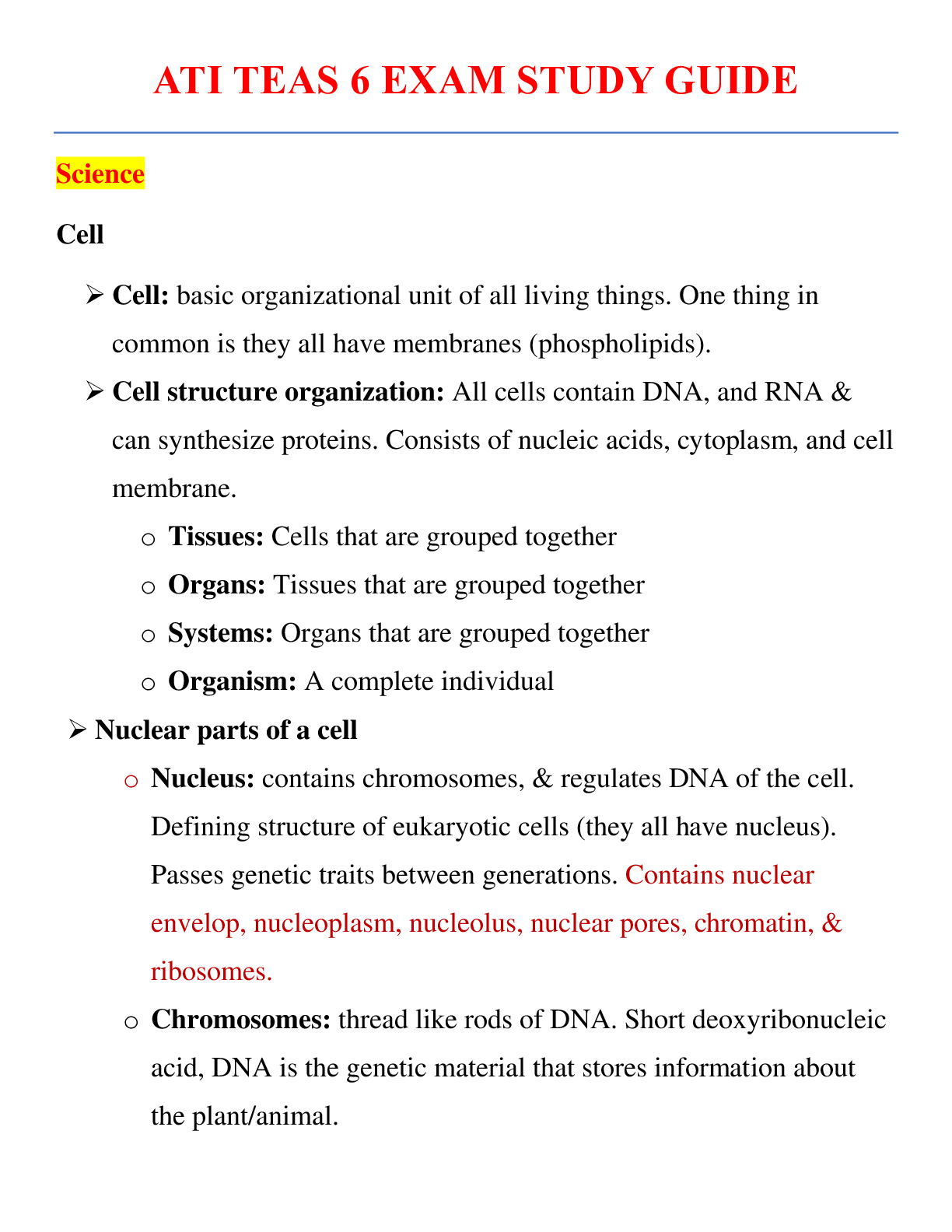
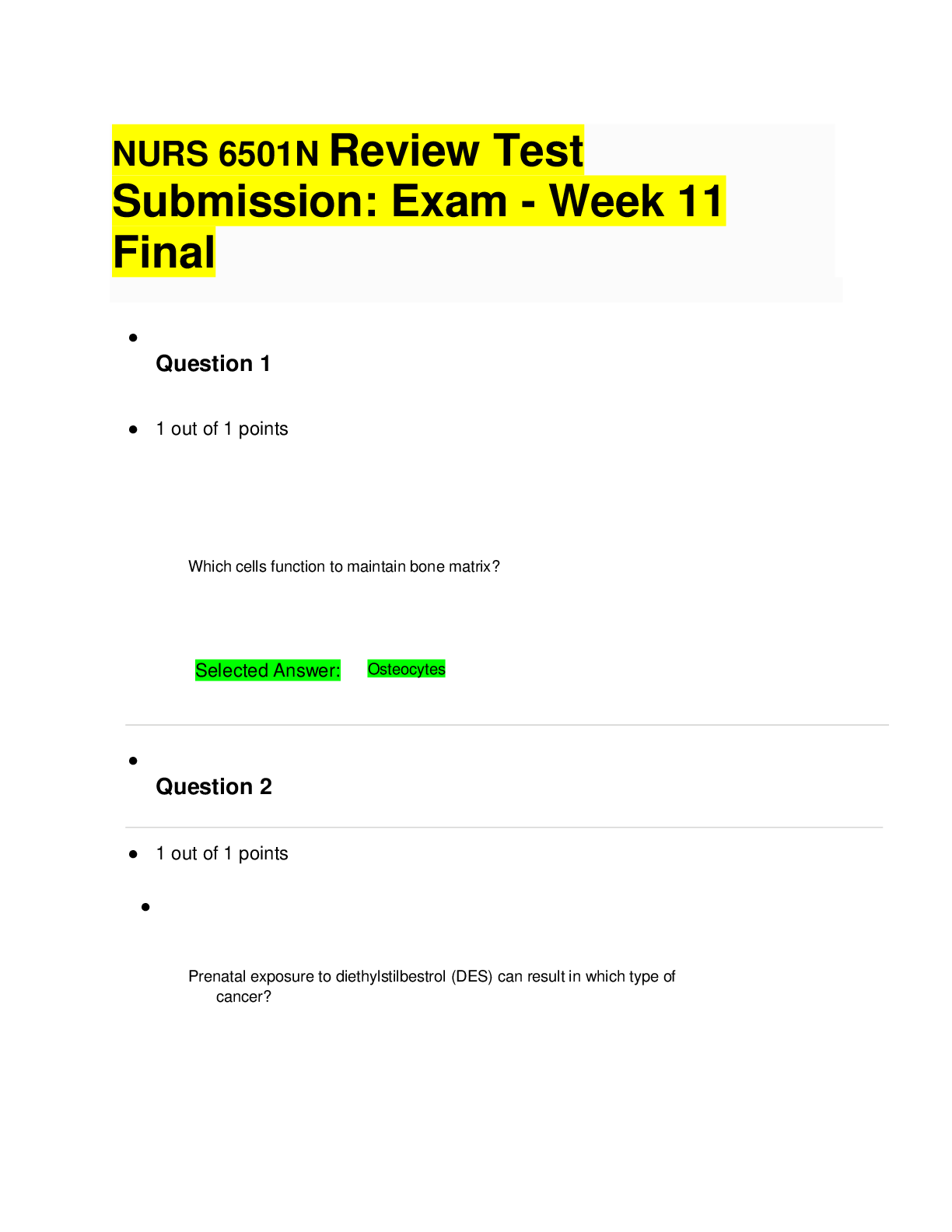
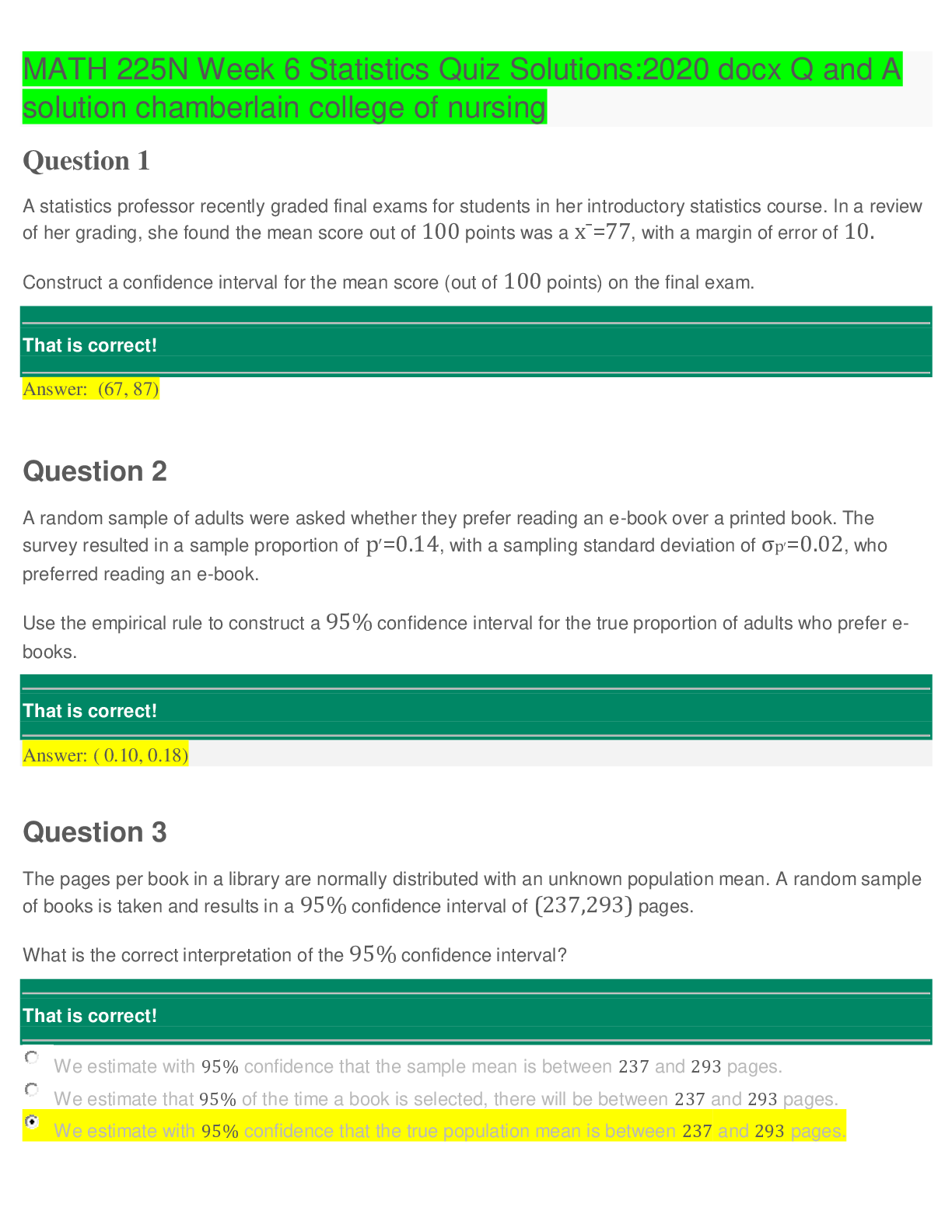
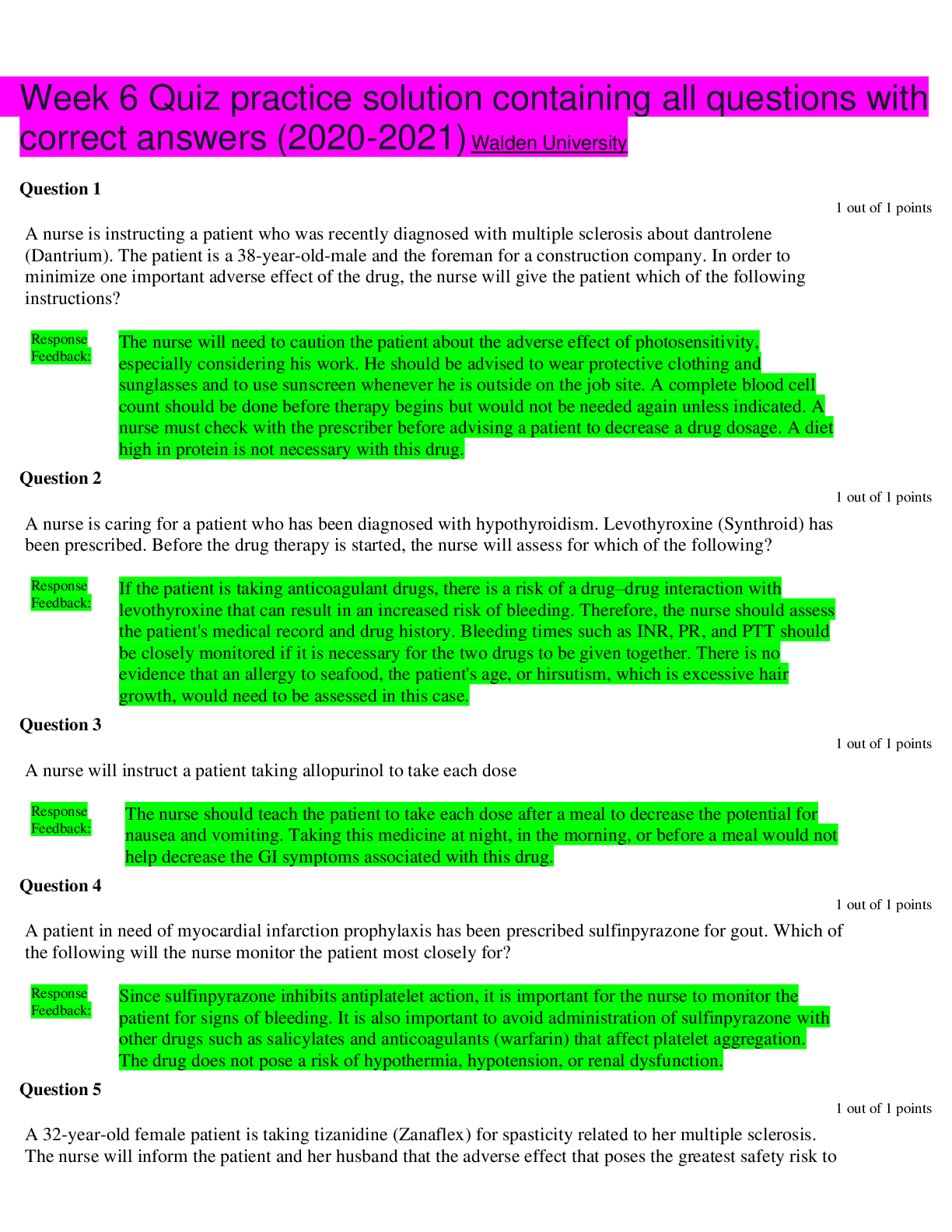
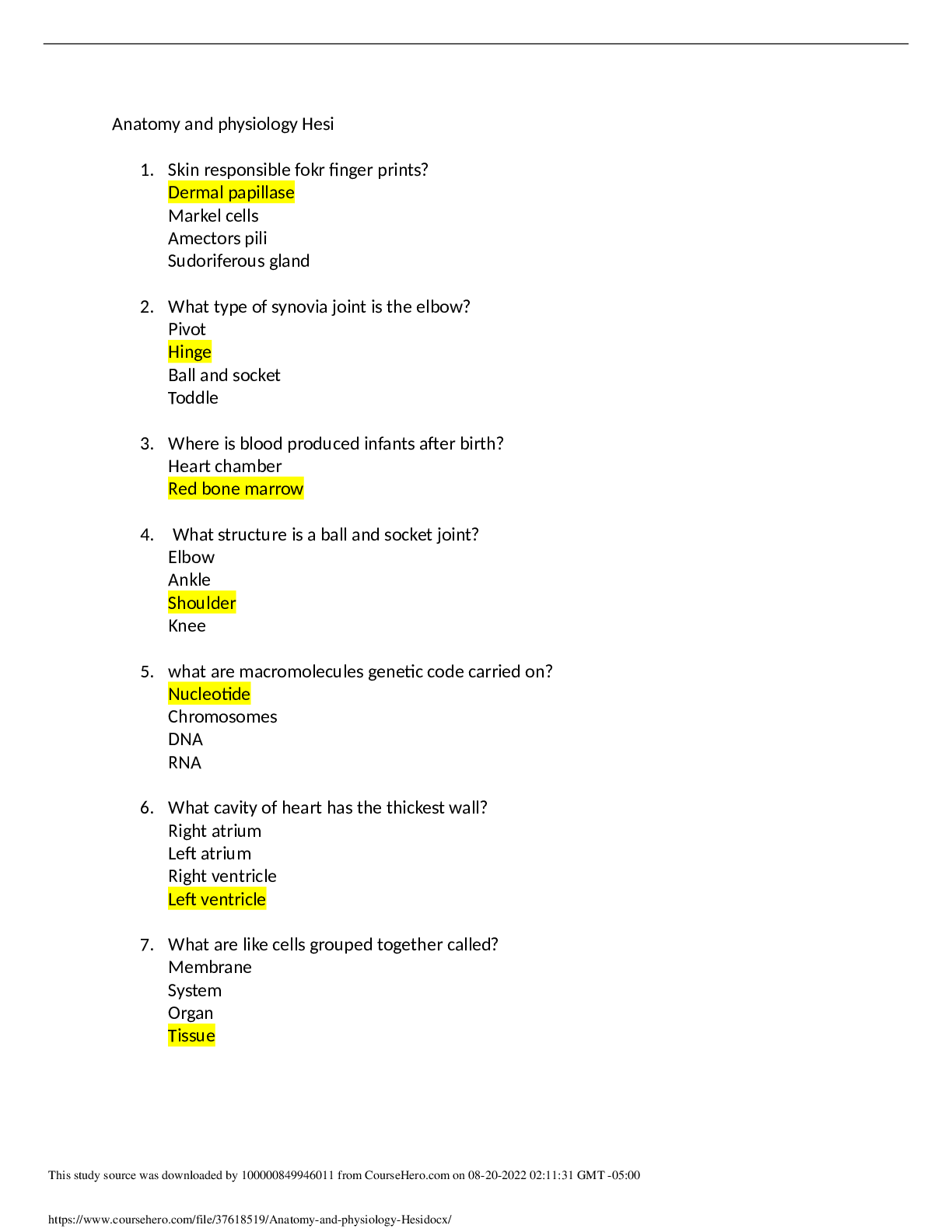
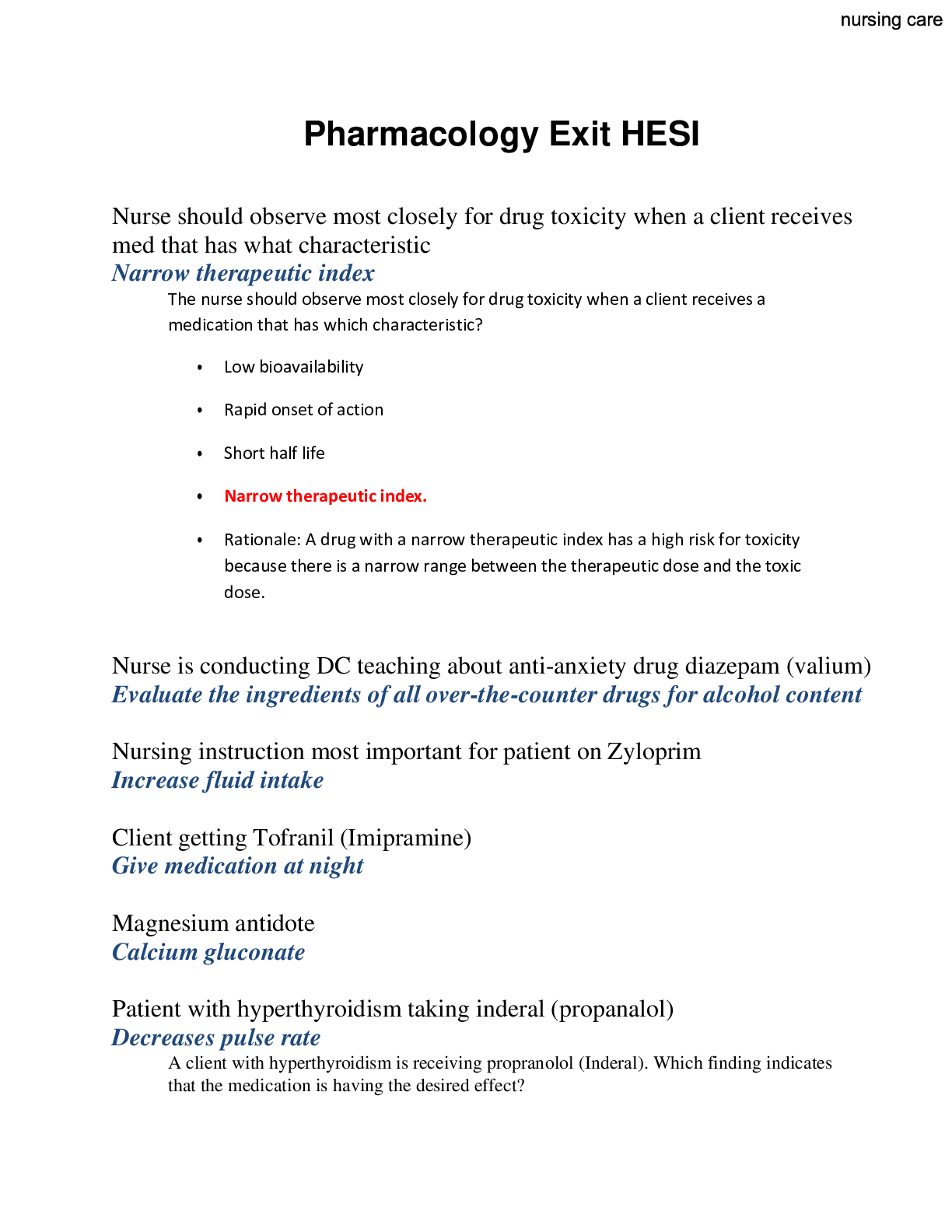
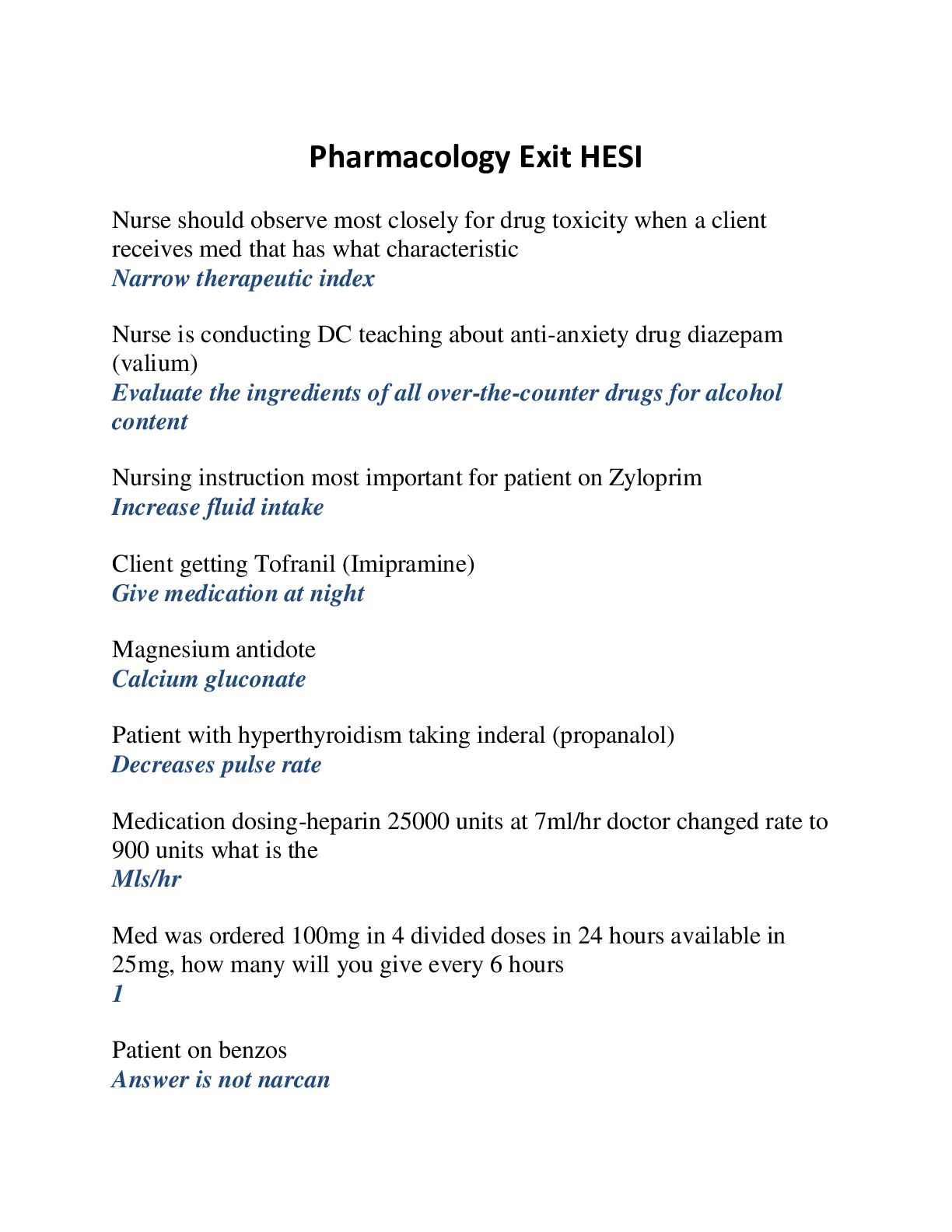
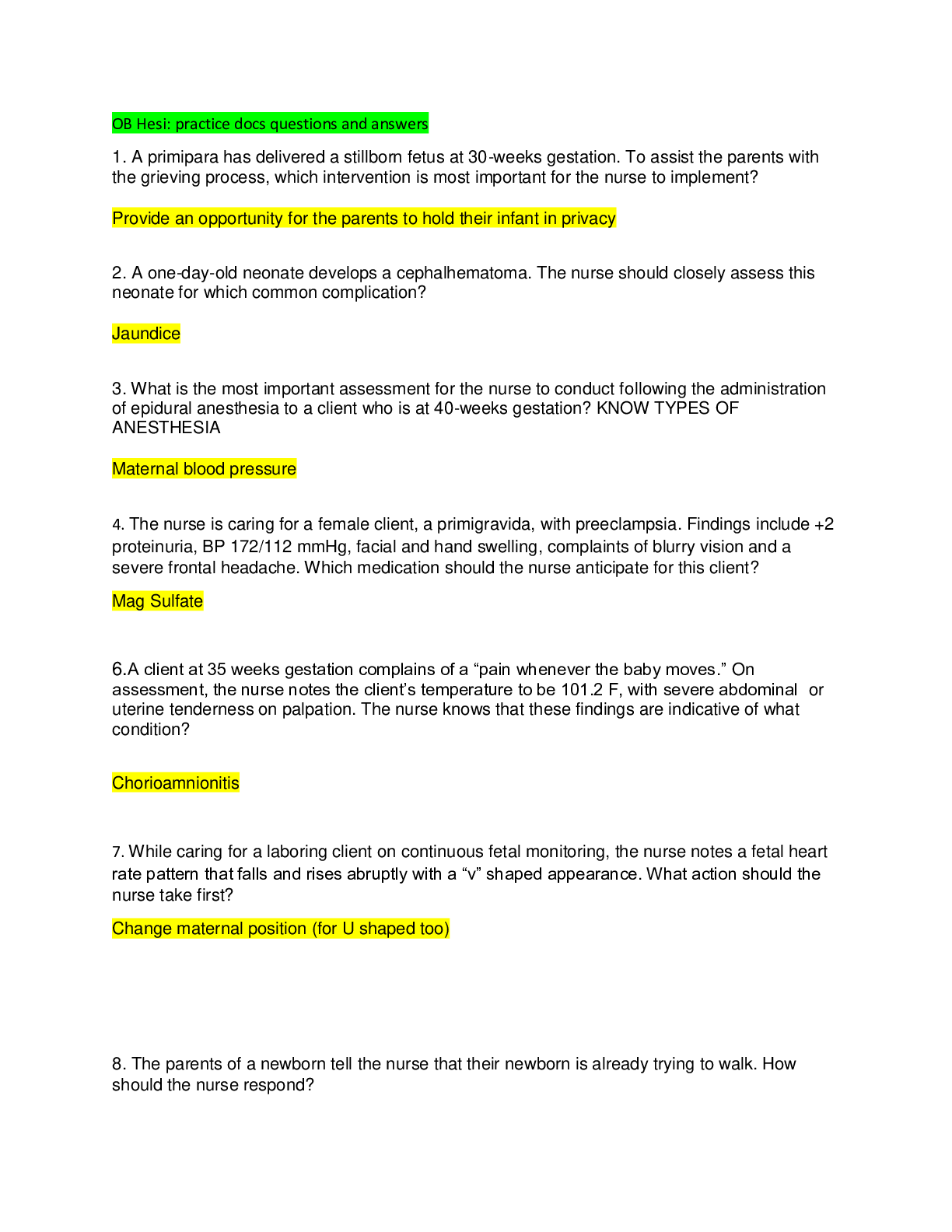
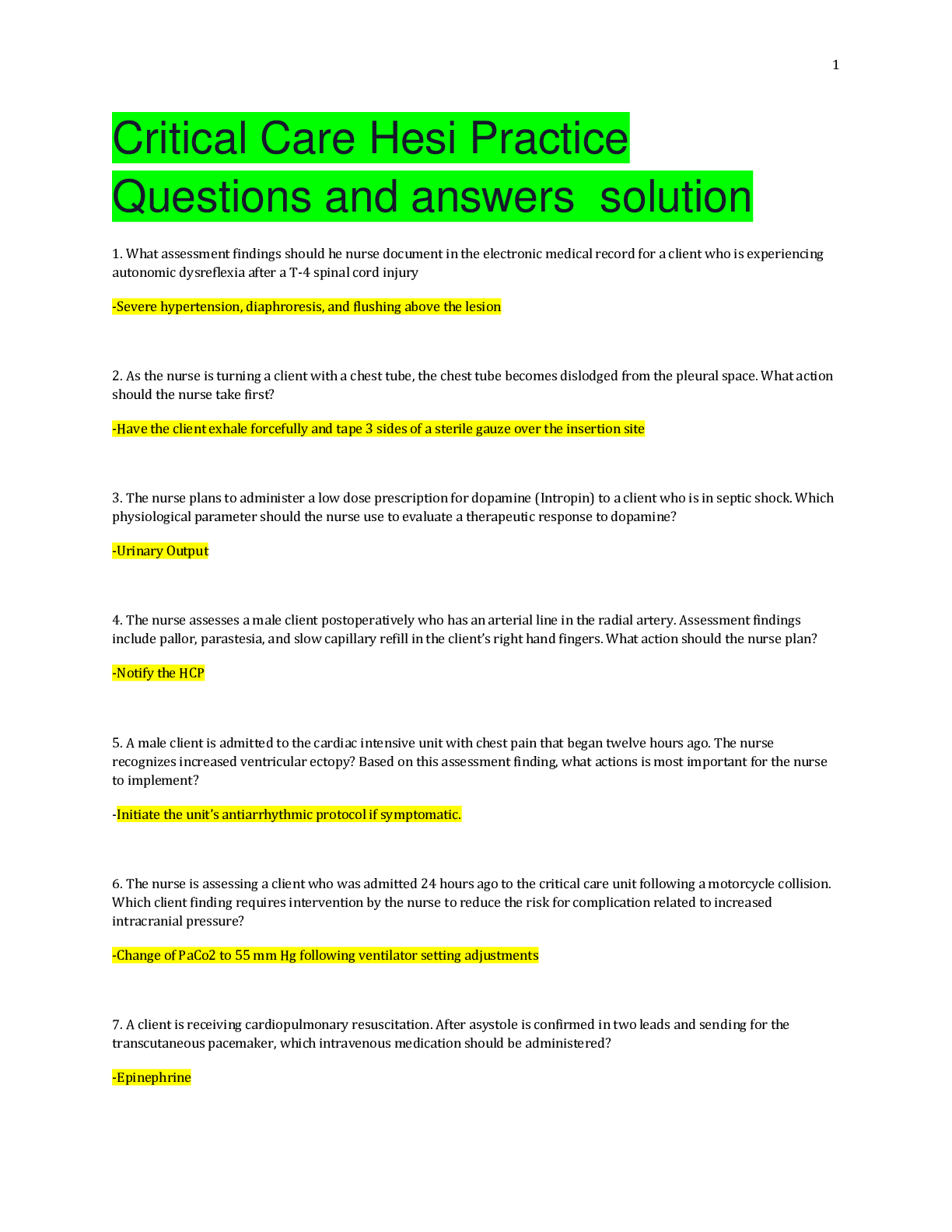
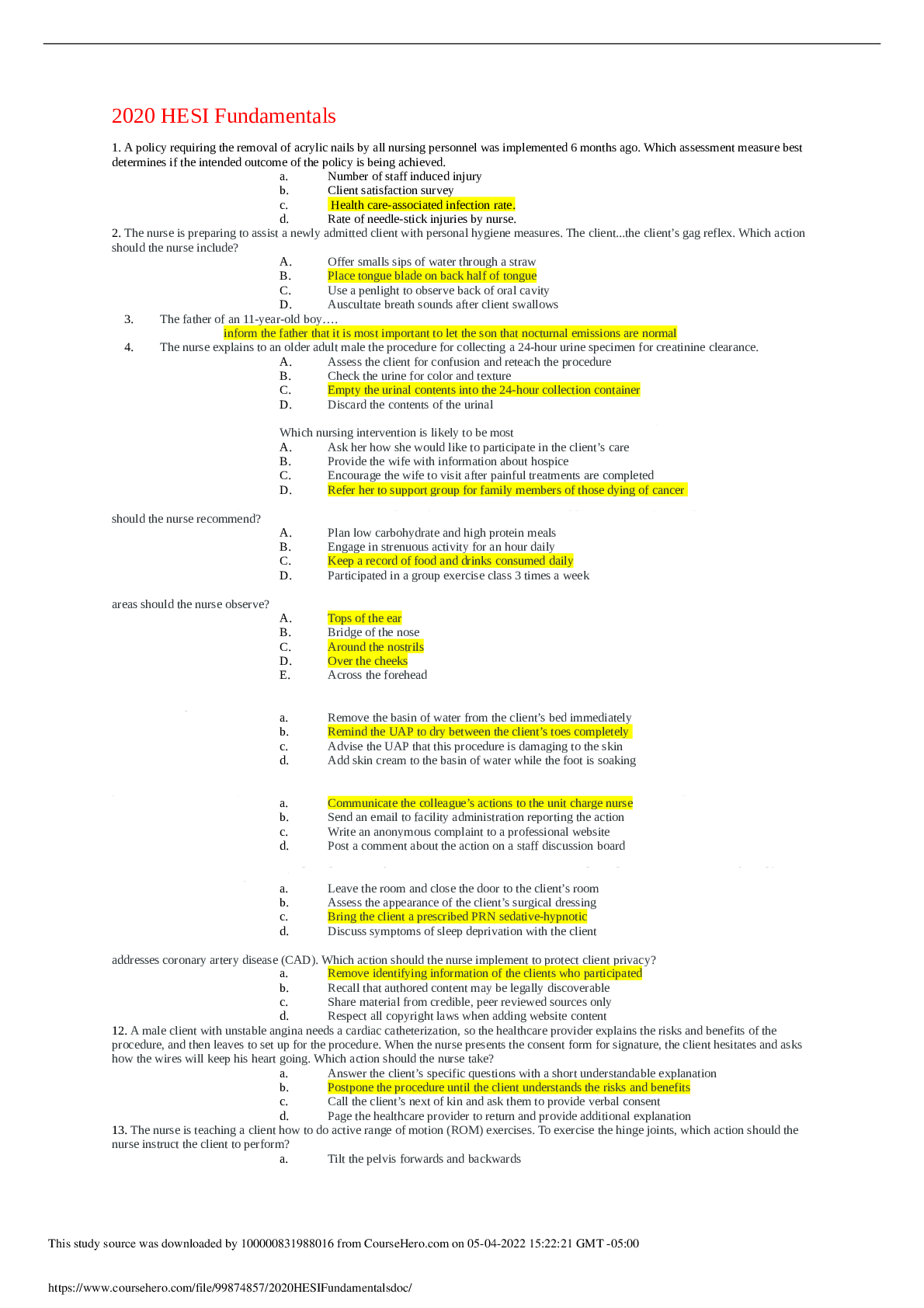
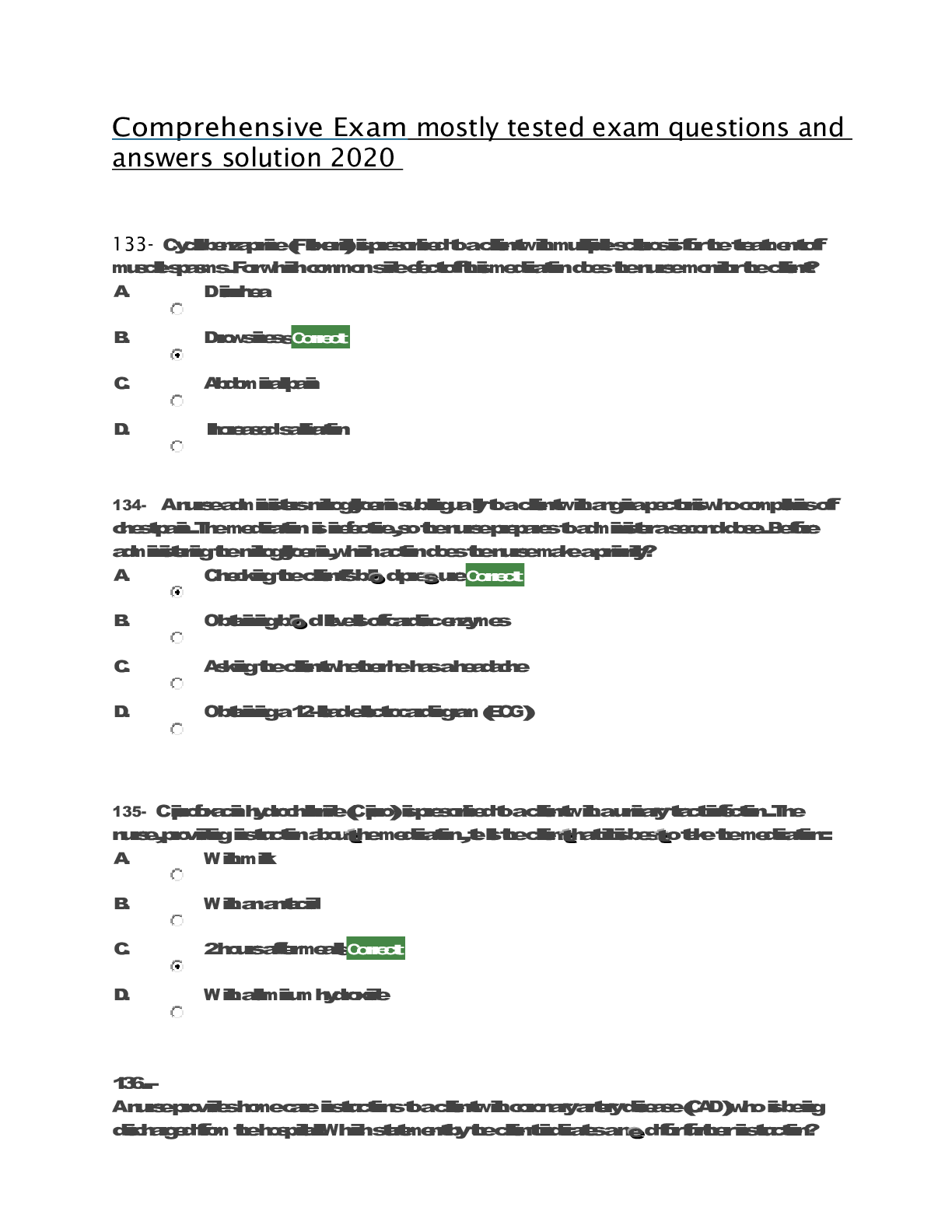


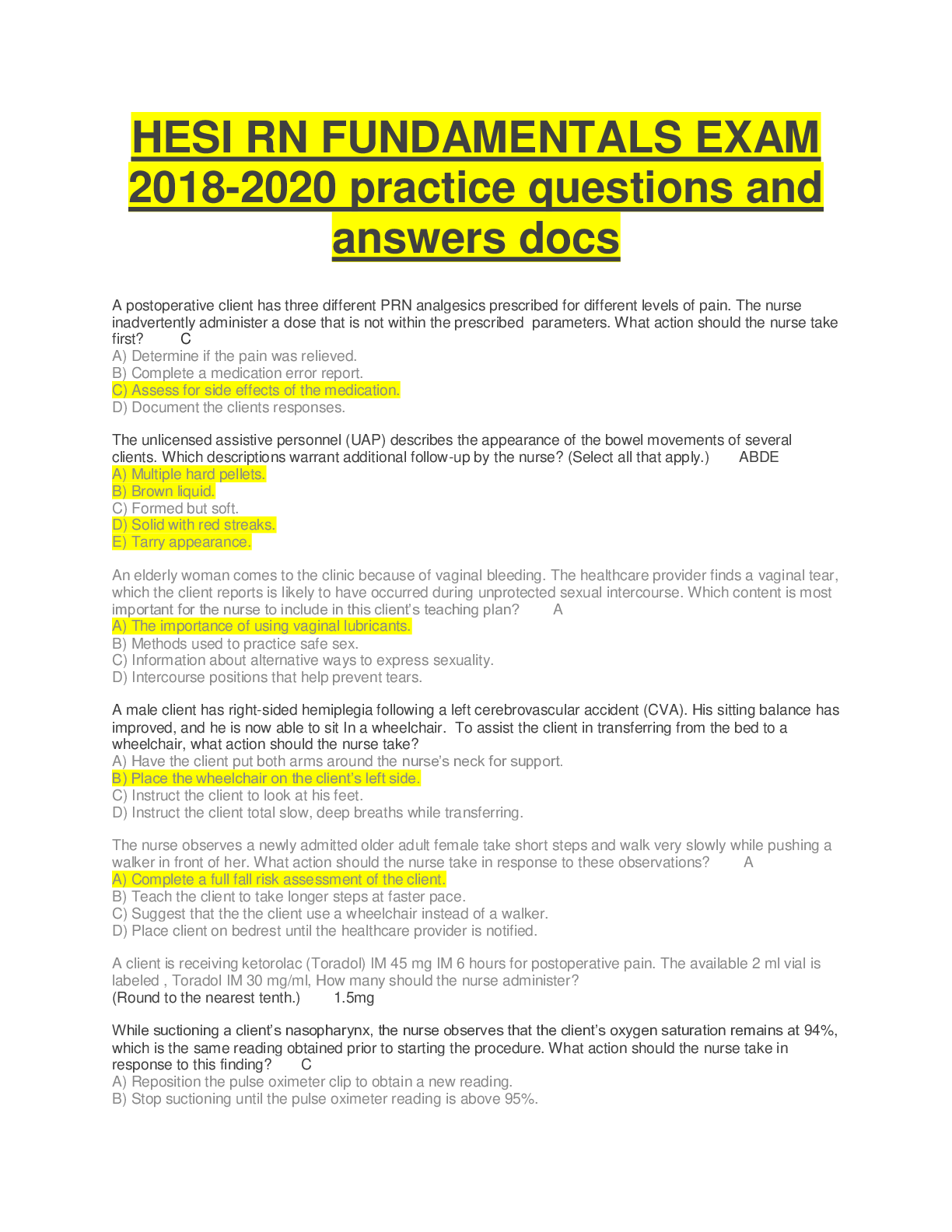
 2020 ans.png)
